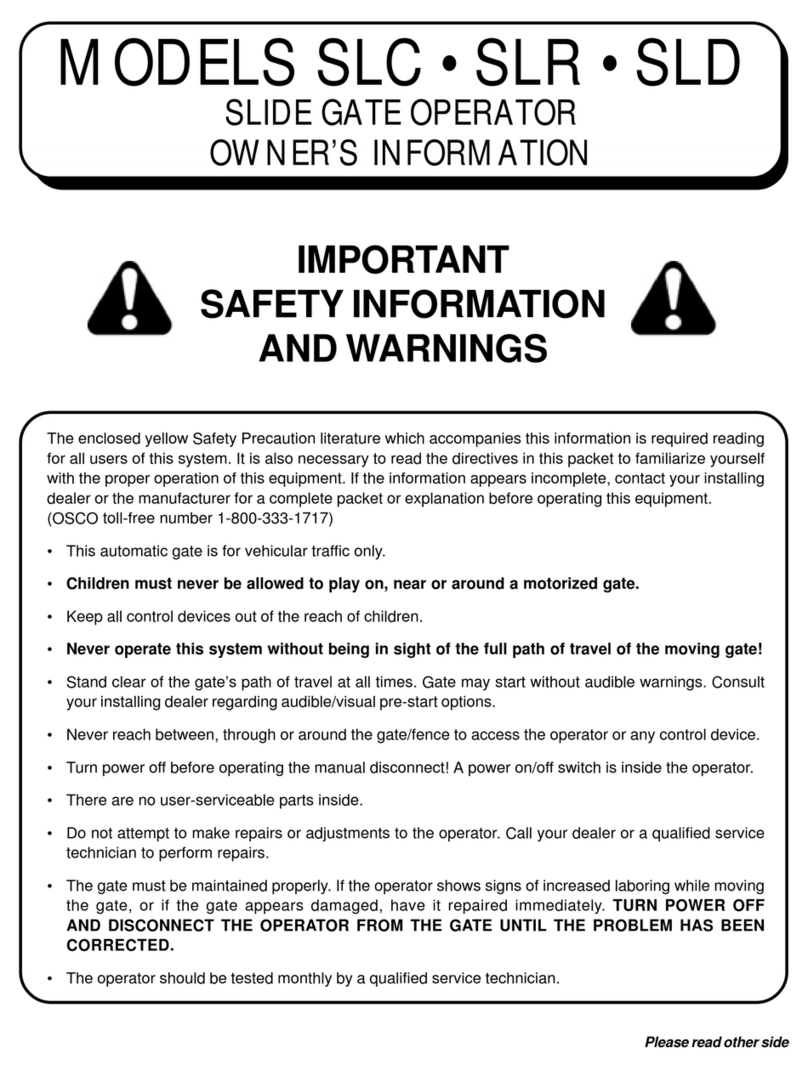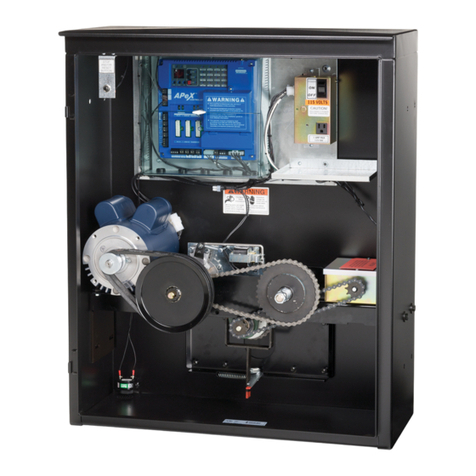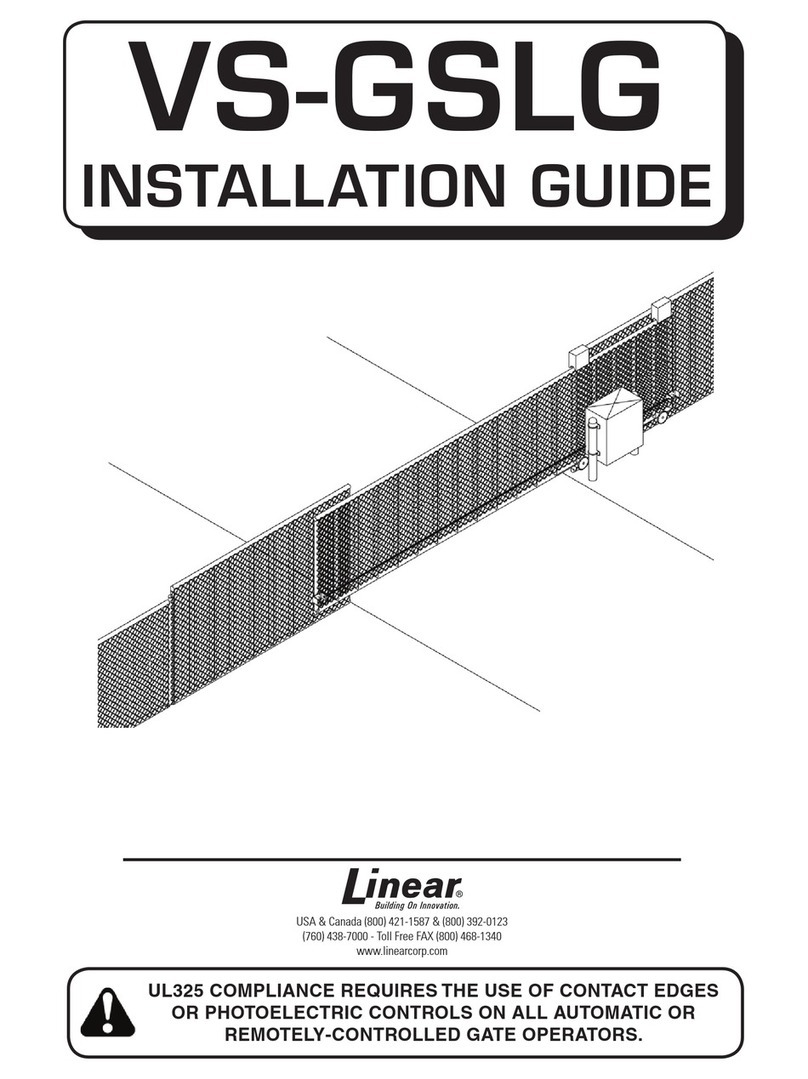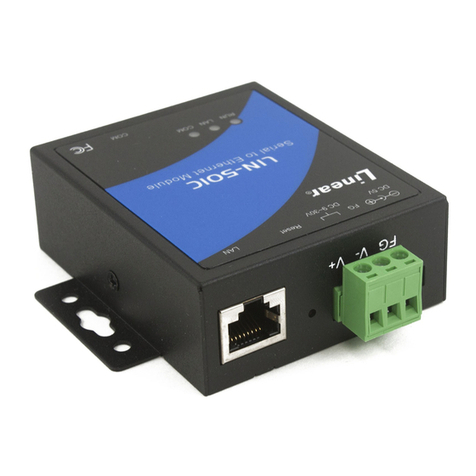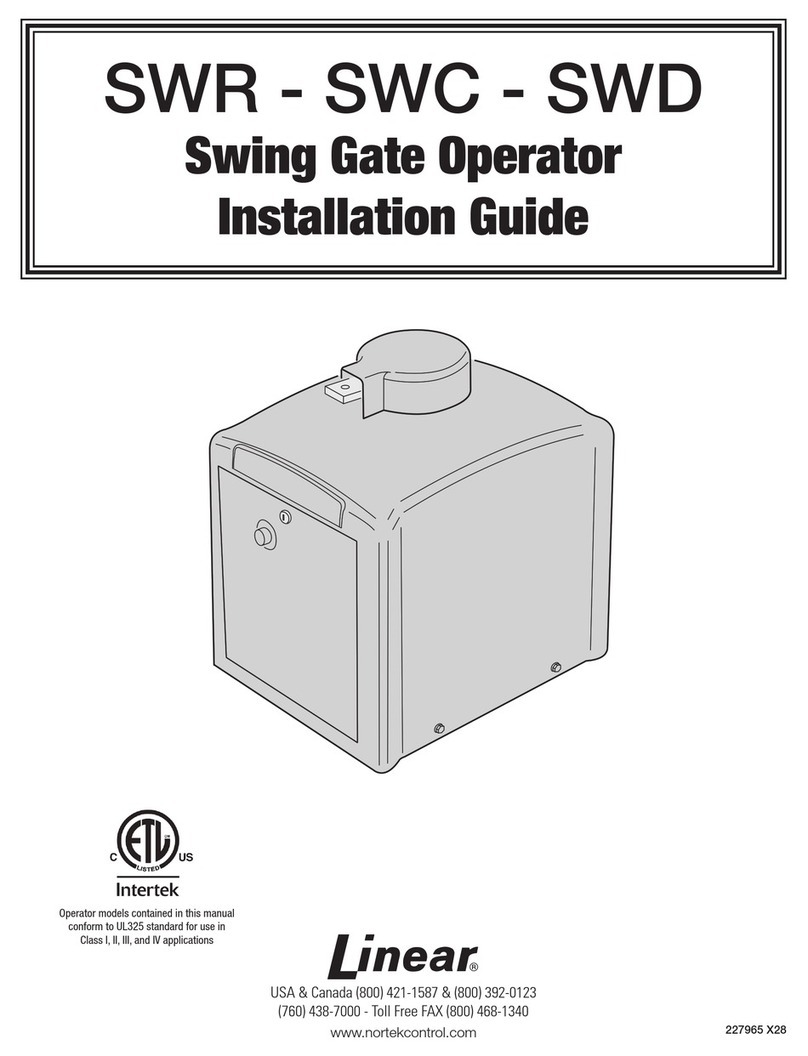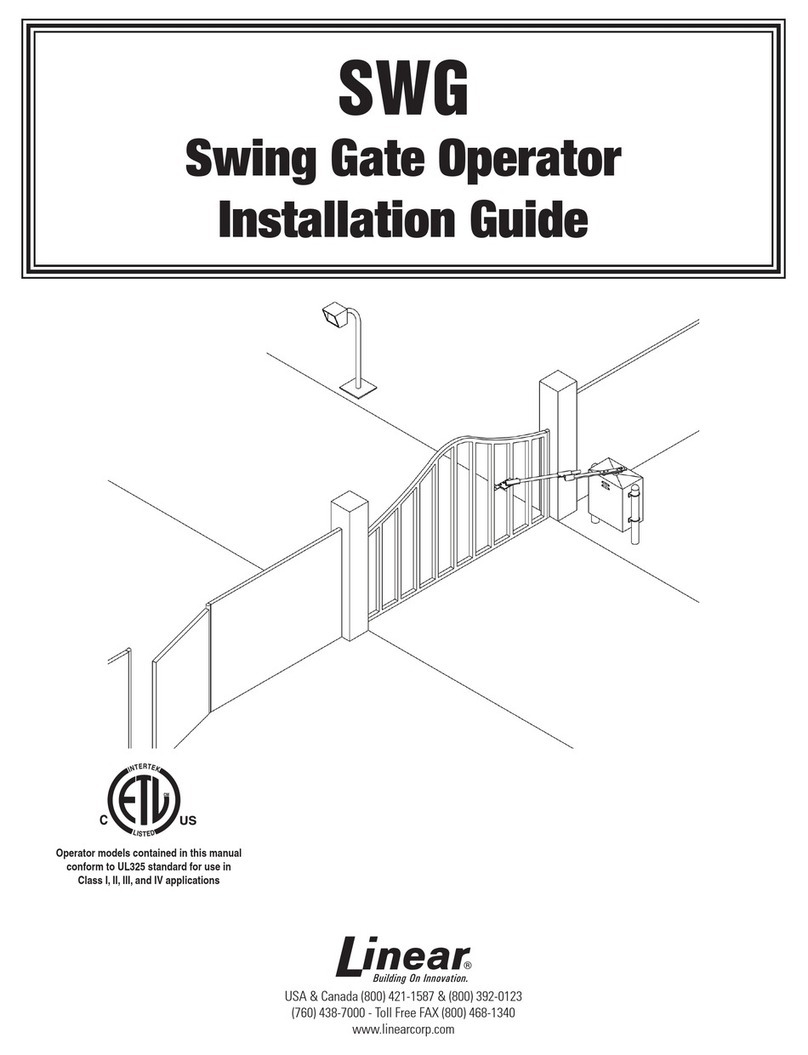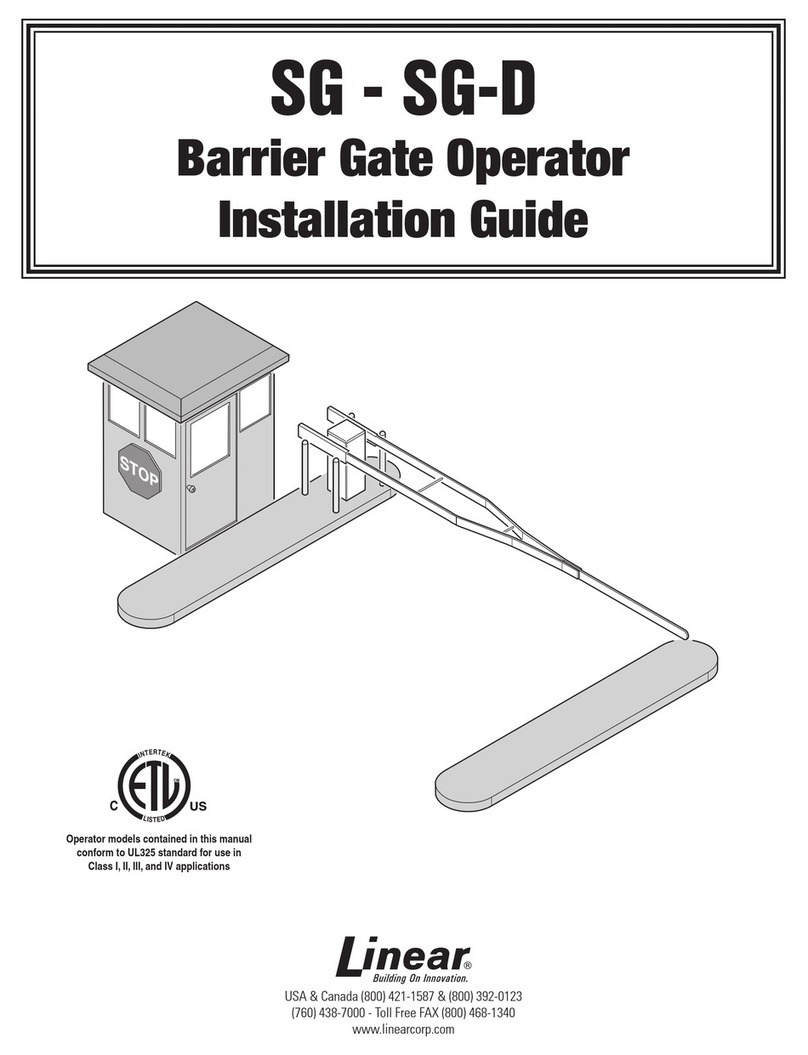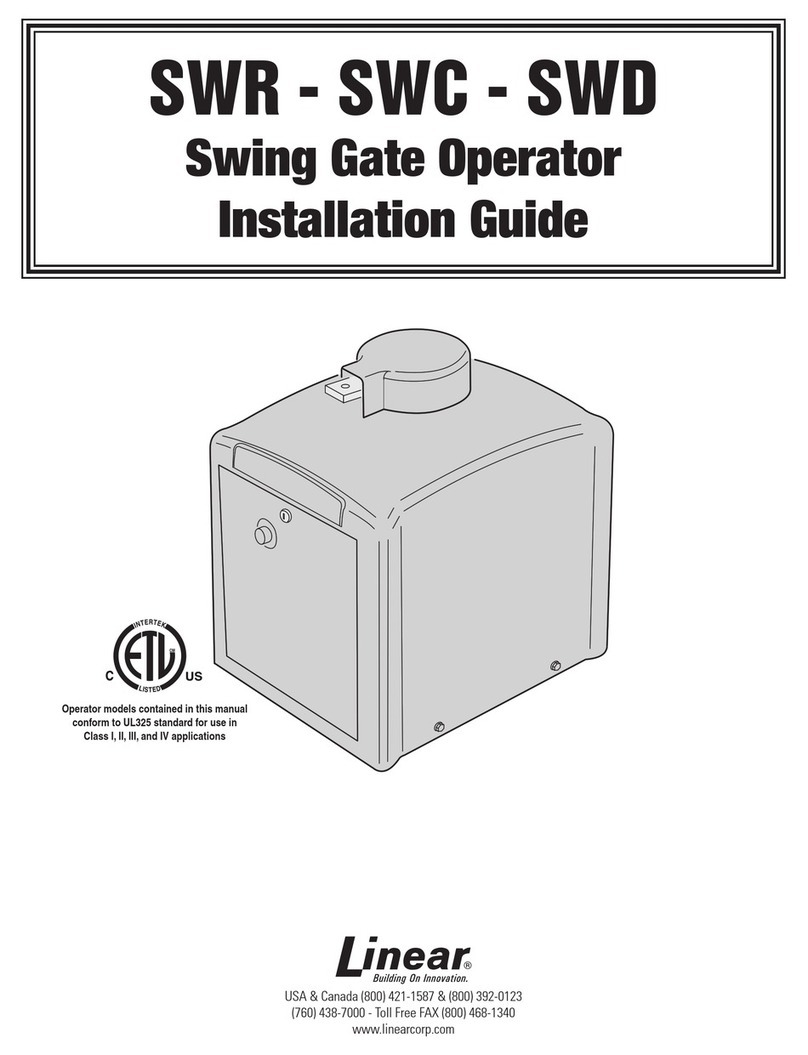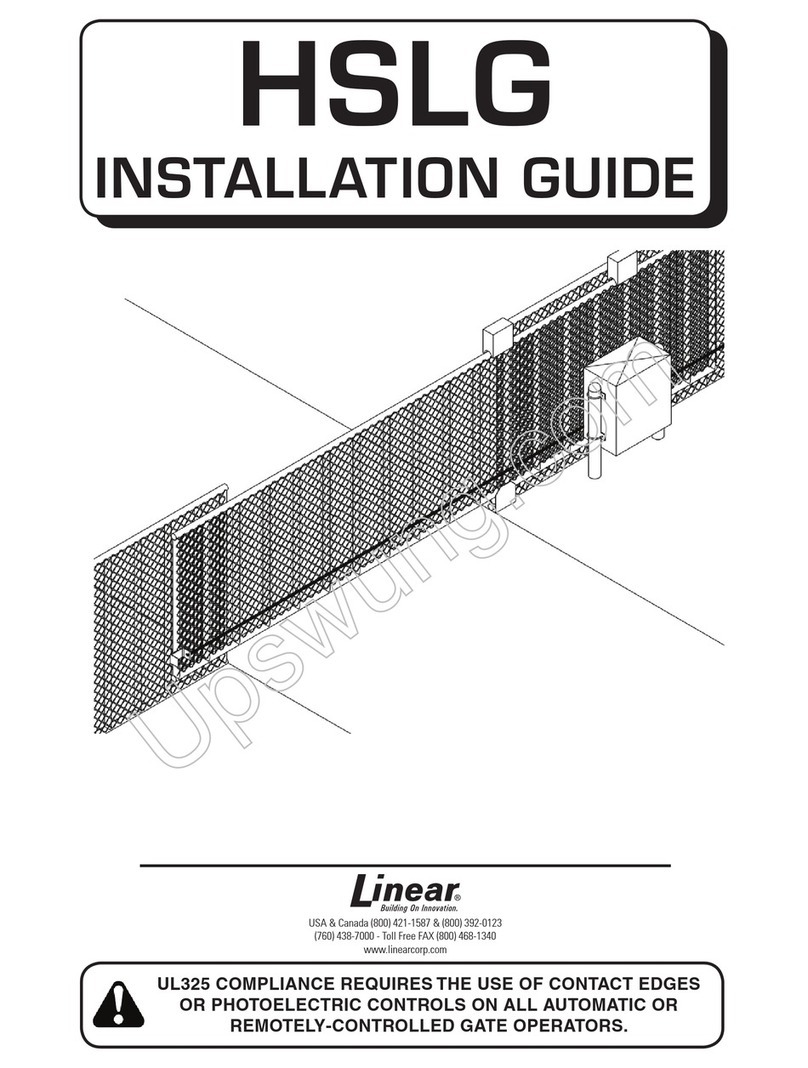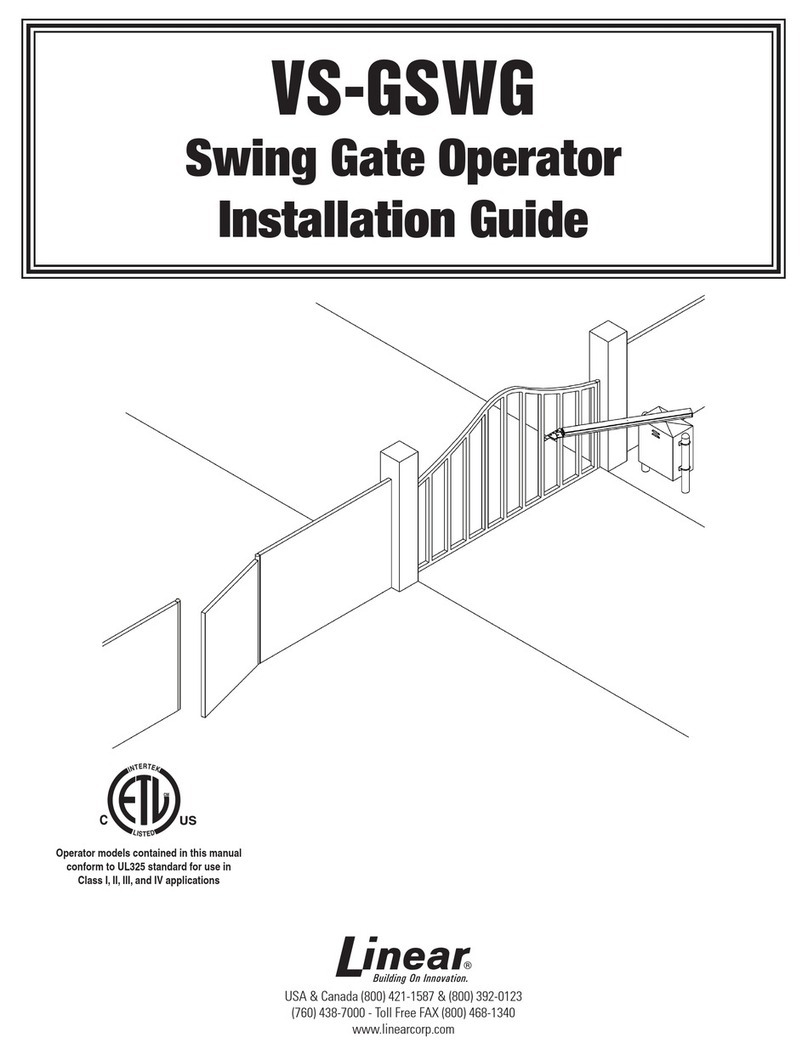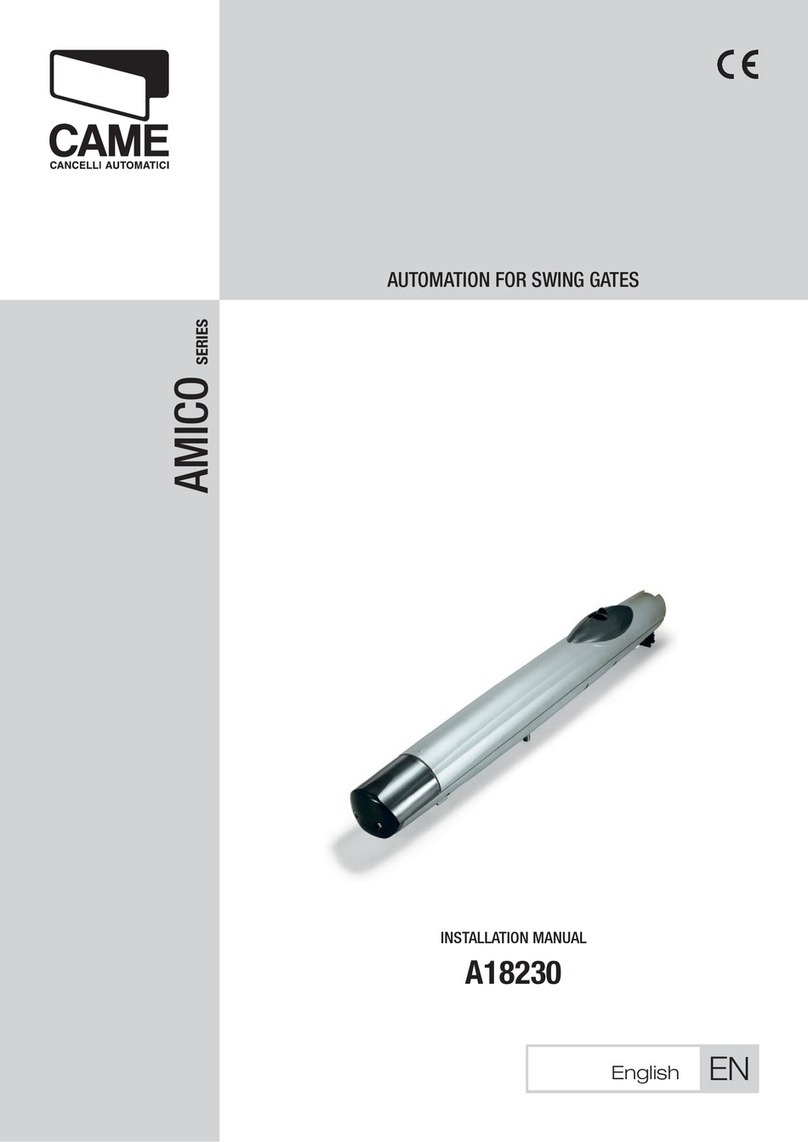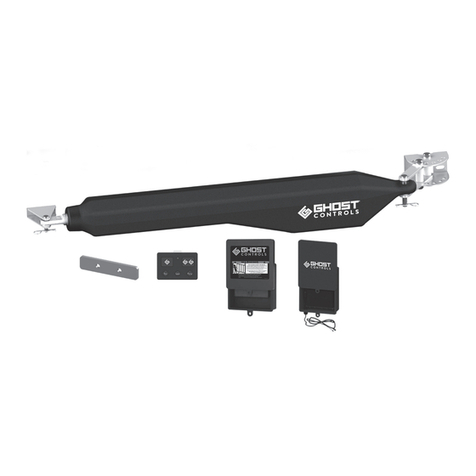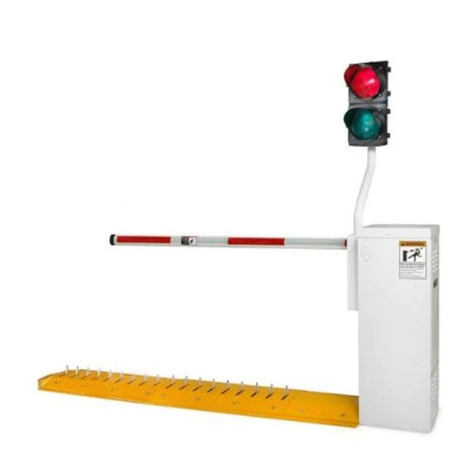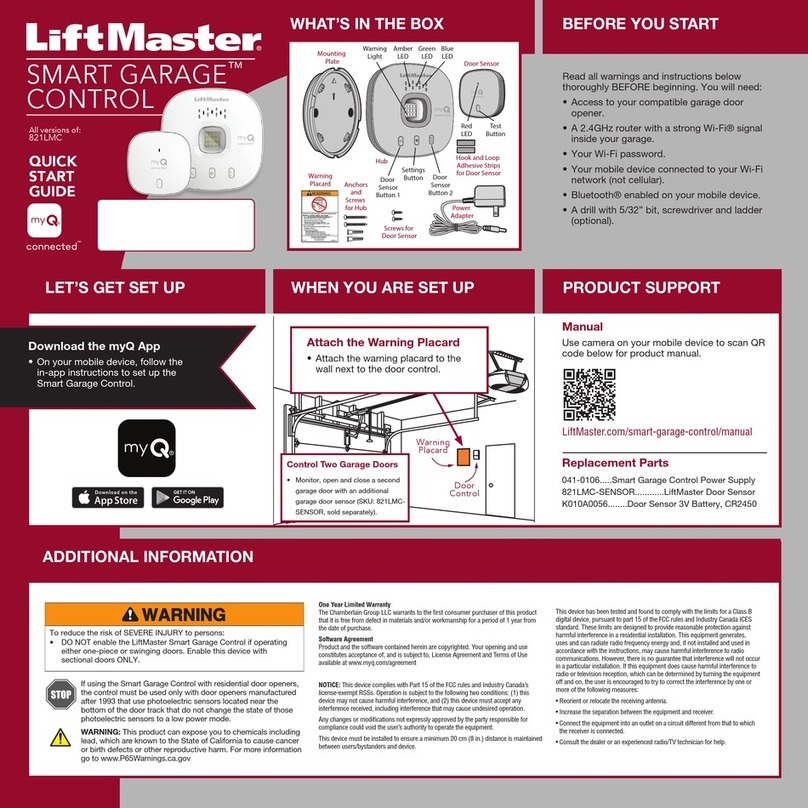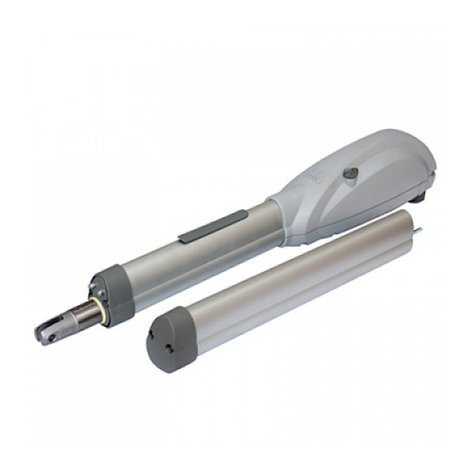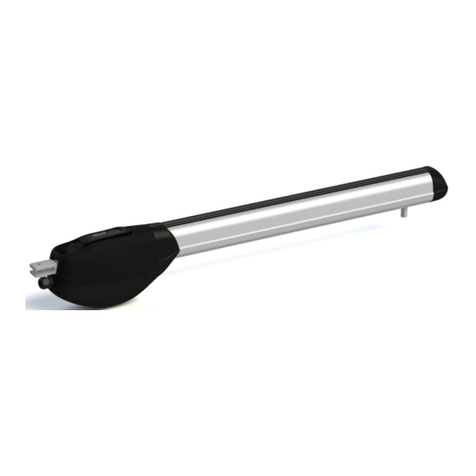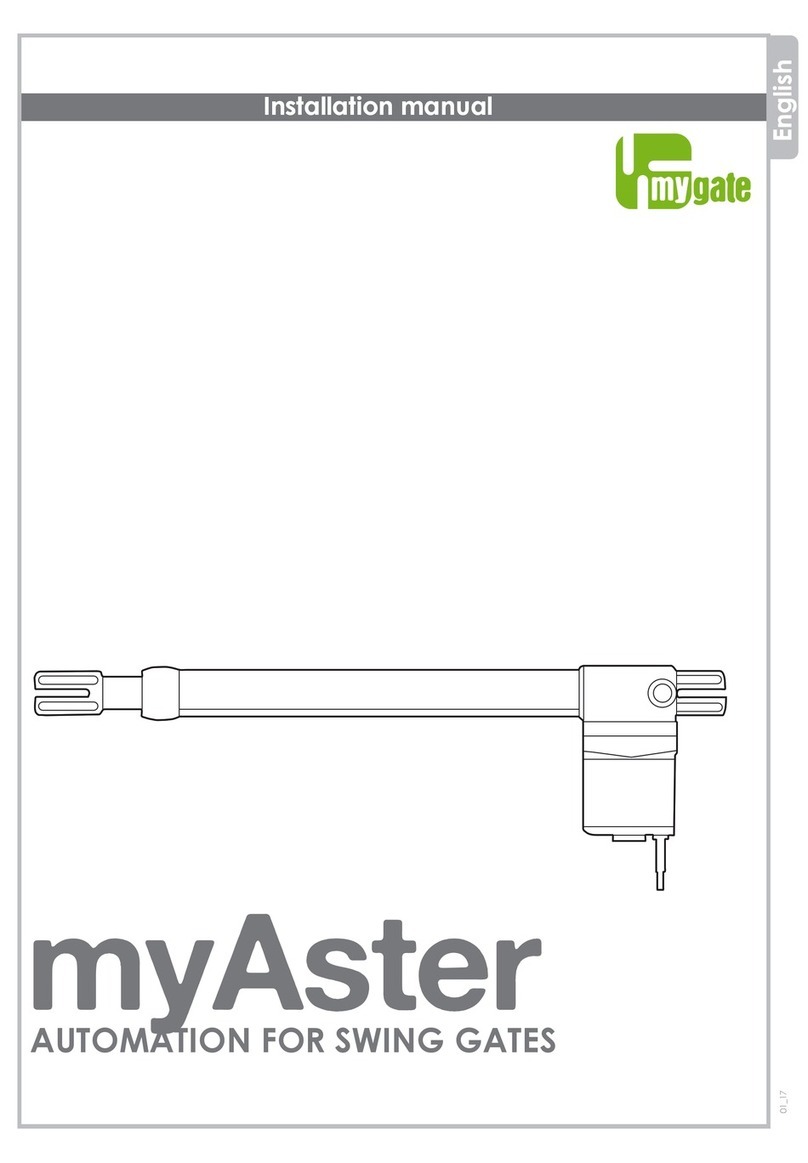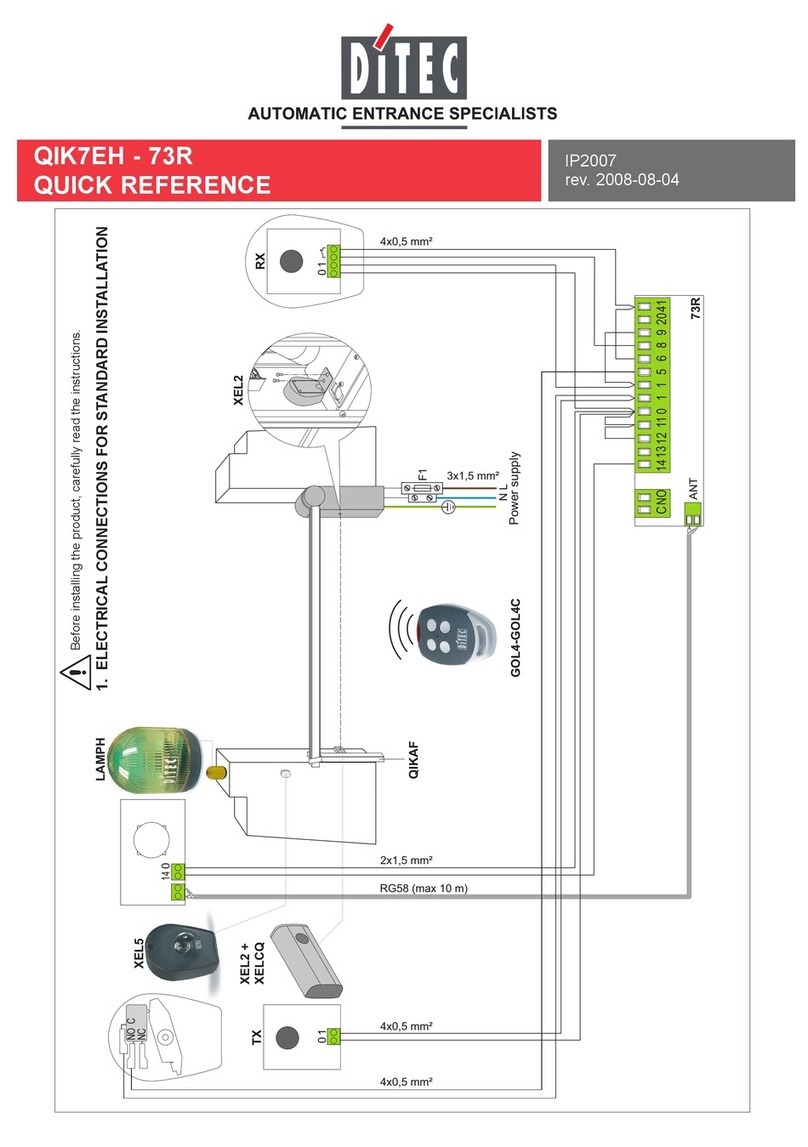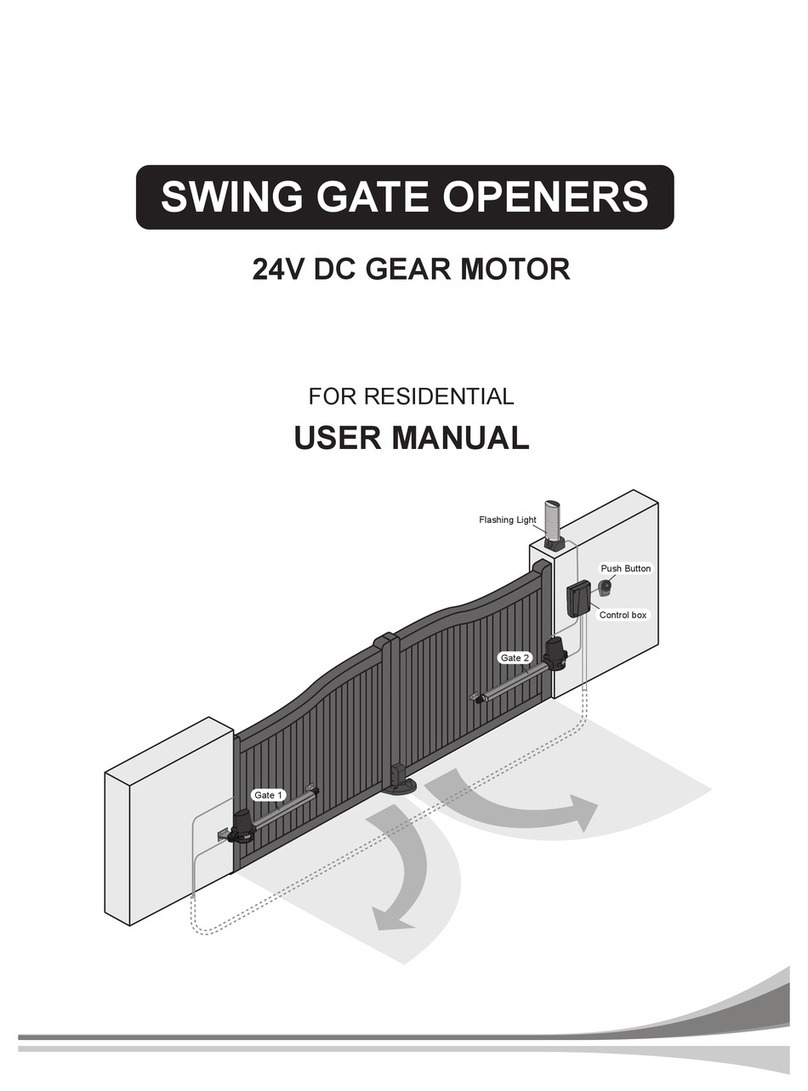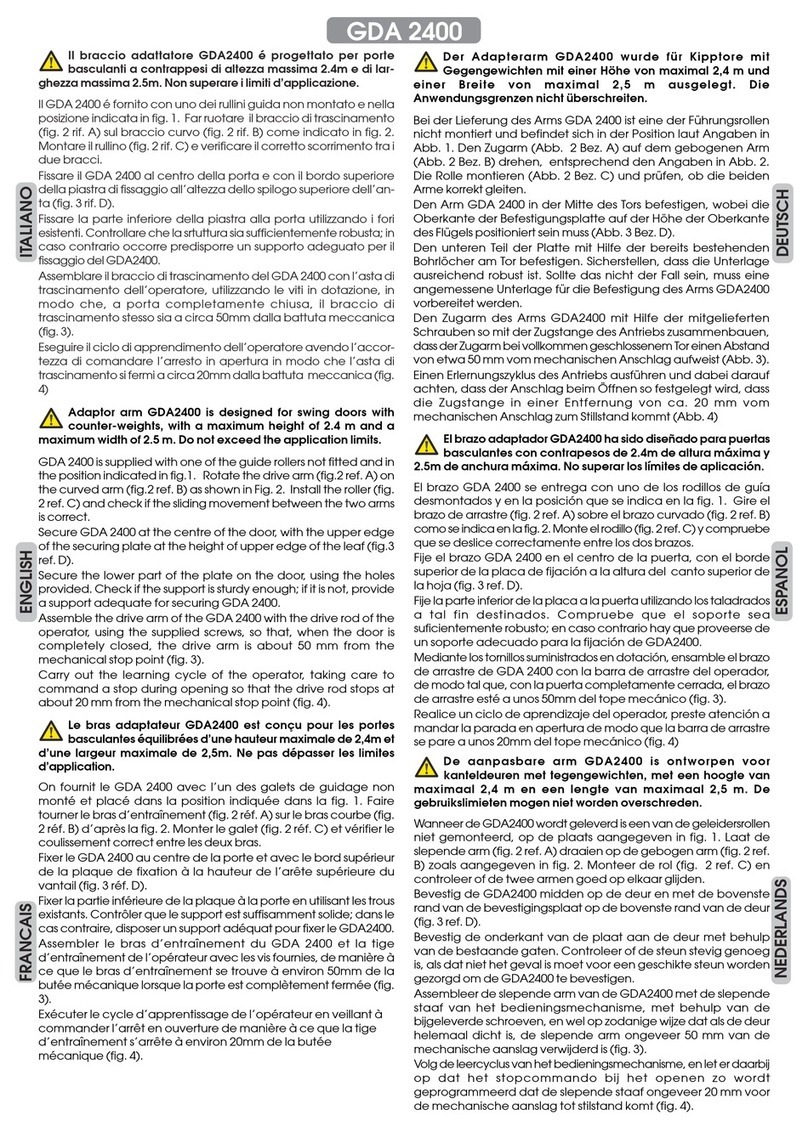Linear Twist'R Plus SX4000 User manual

106502
INSTALLATION AND
OWNER’S MANUAL
Model RSX4000 - Class I
Vehicular Swing Gate Operator
READ THIS MANUAL
CAREFULLY BEFORE
INSTALLATION OR USE
SAVE THESE INSTRUCTIONS
Serial #:
Date Installed:
Your Dealer:
As of date of manufacture,
meets all ANSI/UL 325
Safety Requirements for
Vehicular gate operators
Proven
CGA2K™
TECHNOLOGY!
Twist’R Plus

Pre-Installation Notes..............................................3
Operator Class Information .................................3
Section A: Gate System Design/Installation.........4
Section B: Preparing the Site ................................6
The Concrete Operator Pad .................................6
Alternate Post Mount ...........................................6
Placing the Vehicle Detector Loops....................7
Vehicle Detector Loop Blanking (Shadow).........8
Electrical Power Requirements ...........................8
Section C: Installing the Operator.........................9
Placing the RSX4000 Pedestal Unit...................10
Optional Photoelectric Thru Beam Sensor...........11
Optional Photoelectric Retro-Reflective Sensor..12
Optional Electric Edge Sensor...............................13
Installing the Gate Arm Kit.................................14
Electrical Hookup ...............................................15
Wiring Diagram...................................................15
Lightning Protection ..........................................16
READ THESE STATEMENTS CAREFULLY AND FOLLOW THE
INSTRUCTIONS CLOSELY.
The Warning and Caution boxes throughout this manual are there to protect you and your
equipment. Pay close attention to these boxes as you follow the manual.
WARNING
Indicates a MECHANICAL
hazard of INJURY OR
DEATH. Gives instructions
to avoid the hazard.
CAUTION
Indicates a MECHANICAL hazard
of DAMAGE to your gate, gate
operator, or equipment. Gives
instructions to avoid the hazard.
Indicates an ELECTRICAL
hazard of INJURY OR
DEATH. Gives instructions
to avoid the hazard.
WARNING
Indicates an ELECTRICAL hazard
of DAMAGE to your gate, gate
operator, or equipment. Gives
instructions to avoid the hazard.
CAUTION
WARNING HIGH VOLTAGE
ONLY A QUALIFIED TECHNICIAN SHOULD SERVICE THIS GATE OPERATOR
PERIODICALLY TEST SENSITIVITY OF OVERLOAD *** READ MANUAL ***
DATES OPERATOR
DATE TESTED DATE TESTED DATE TESTED DATE TESTED SERVICED
LOG DATE OVERLOAD TEST
Right/Left Hand Installations .............................16
Synchronous Operation (Master/Slave ............16
Accessory Equipment Hookup.............................17
Terminal Strip Reference Chart ............... 18 & 19
Section D: Starting the Operator.........................19
Setting the Limit Switches ................................19
Setting the Adjustable Torque Drive ................20
Running the RSX4000 Plus ...............................21
Maximum Run Timer..........................................22
Final Setting of Close Timer..............................22
Section E: Auxiliary Equipment ..........................22
Section F: End User Instructions .........................23
Operational Guide for the End User .................23
Safety Guide for the End User ................. 24 & 25
Wiring Diagram ..................................................26
Notes .....................................................................27
RSX4000 Arm Kit Exploded View .........................27
Technical Specifications.......................................28
TABLE OF CONTENTS
2
Figure 1

The Twist’R Plus (Model RSX4000) Vehicular Gate Operator will
provide convenience and assurance to the ultimate users for many
years. It is ruggedly built of the finest materials and has been
thoroughly inspected and tested at the factory. It has many features that
will aid in the installation and testing of the complete gate system. The
RSX4000 has been designed and built to comply with the UL325
Standard For Safety, Fourth Edition, revised March 1, 2000 as
established by Underwriters Laboratory Inc.
The RSX4000 Vehicular Swing Gate Operator is designated a Class
I Vehicular Swing Gate Operator, and is intended to operate a
vehicular swing gate installed on a residential home, maximum of four
single families in the dwelling, or a garage or parking area associated
with that home, or a similar location with respect to the cycle usage (see
below). Gate operators are also manufactured for the three other Class
designations (as defined by UL325); Class II (high cycle usage
commercial location or multi-family home); Class III (Industrial
location not intended to service the general public); and Class IV
(secure or restricted access locations, ie. airports and prisons). The
RSX4000 operator cycle usage is rated at a maximum of 10 cycles per
hour, 50 cycles maximum per day.
Because the RSX4000 (as well as gate operators sold by other
manufacturers) is designed to start and move gates weighing as much as
300 pounds and 16 feet in length. As such, the RSX4000 is capable of
producing high levels of force. It is important in the design of the total
gate system that designers, installers and users be aware of the hazards
that may be associated with the IMPROPER design, installation and
use of Vehicular Gate systems and Gate Operators.
The gate operator is only one part of a complete automatic gate
operating system. As each location and usage is different, a properly
designed system will include all applicable safety enhancement devices.
As the designer and installer of the GATE SYSTEM, you must
advise the purchaser on the proper use of the gate system. You also
have the primary responsibility of insuring that ALL possible
operational hazards have been considered and eliminated.
The RSX4000 CGA2K™ technology provides several features that
can help reduce the hazards of your gate system.
Built-In Adjustable Torque Limiting Drive System
The RSX4000 is provided with a adjustable torque limiting drive
system that may be adjusted to “slip” when an obstruction is
encountered. This system, however, must not be considered as the
primary obstruction sensing system. Consider all available options
(electric leading edges, photoelectric sensors, protective screen mesh,
etc.) to eliminate hazards in your gate system design.
The torque limiting drive system also serves to protect the mechanical
components of the operator.
The torque limiting drive setting is an adjustable setting that must be
determined at the time of installation. This setting must be tested
periodically to ensure proper operation. The more freely the gate will
move the more sensitive the setting can be made. See Page 17.
ADVISE THE PURCHASER TO CHECK THE SENSITIVITY OF
THE GATE OPERATION PERIODICALLY AND THEN LOG THE
DATE TESTED IN THE TABLE on page 2. (See Figure 1)
Connections for External Entrapment Prevention Sensors
Because all gate system installations are different, the RSX4000 control
panel provides independent connections for Open and Close contact
(edge) sensors and Close non-contact (photoelectric) sensors. In this
way a photoelectric sensor could be utilized to guard the gate area when
closing and an edge sensor would provide the protection when opening.
Depending on the particular application a combination contact and non-
contact sensor protection system for the open and close directions may
provide more effective entrapment protection than a single device for
both directions. See pages 4, 5, 11, 12, 13, 17, 19, 23, and 24.
SMART™ Self adjusting MAximum Run Timer
The RSX4000 has a Self adjusting MAximum Run Timer, SMART™.
The amount of time for the first few cycles of operation are registered
and averaged within the motor controller circuitry. After the first few
initial cycles, if the gate is activated and no other command is given or
an end limit (open or close) is not reached in the previously counted
cycle time plus approximately 4 seconds, the operator will be turned
off. See page 22.
OTHER FEATURES
Auto Close Timer: Adjustable from 2 to 60 seconds, provides an
automatic closure of the gate from the full open position. See page 21.
Synchronous Operation (Master/Slave): Two RSX4000 units can be
wired together to operate as one system, with one unit controlling the
movement of both. Additionally, the installer can customize the
installation of the external entrapment protection devices. These
devices can be wired to the controller operator or alternately to the
individual units as the situation dictates or the end user requires. See
Page 16.
NOTICE
THE IMPORTANT SAFEGUARDS AND
INSTRUCTIONS IN THIS MANUAL CANNOT COVER ALL
POSSIBLE CONDITIONS AND SITUATIONS WHICH MAY
OCCUR DURING ITS USE. IT MUST BE UNDERSTOOD
THAT COMMON SENSE AND CAUTION MUST BE
EXERCISED BY THE PERSON(S) INSTALLING,
MAINTAINING AND OPERATING THE EQUIPMENT
DESCRIBED HEREIN. DO NOT USE THIS EQUIPMENT
FOR ANY OTHER THAN ITS INTENDED PURPOSE —
OPERATING A SWING GATE.
NOTICE
BEFORE ATTEMPTING INSTALLATION,
READ THIS MANUAL CAREFULLY SO YOU WILL
BE THOROUGHLY FAMILIAR WITH THE
FEATURES OF THE TWIST'R PLUS AND IT’S
PROPER INSTALLATION PROCEDURES.
PRE-INSTALLATION NOTES 3

TO REDUCE THE RISK OF SEVERE INJURY
OR DEATH: READ AND FOLLOW ALL
INSTALLATION INSTRUCTIONS AND GATE
SYSTEM DESIGN PARAMETERS!
WARNING!
GATE SYSTEM DESIGN AND INSTALLATION
SAFETY CHECK LIST:
• The RSX4000 operator may be installed on a Class I Vehicular
Swing Gate. See page 3 for an explanation of the different Class
locations. See the last page of this manual for the operator
specifications (voltage, maximum gate weight & length etc.).
• Make sure that the gate moves freely, all hinges are in good
working order, the gate does not bind in any manner and the gate
swing area is clean and free of irregularities. DO NOT INSTALL
THE OPERATOR UNTIL ALL GATE PROBLEMS HAVE
BEEN CORRECTED.
• Do not increase the built-in overload detector adjustment or
overtighten the torque limiter to compensate for a poorly working
gate. A well maintained gate will ensure easy manual operation (if
needed) and maximum operator obstruction sensitivity.
• Install the operator on the inside of the property/fence line. DO
NOT install an operator on the public side of the fence line or gate.
Outward swinging gates should not open into public areas.
• Make sure the gate operating system is placed far enough back
from the road to eliminate traffic backup. The distance from the
road, size of the gate, usage level and gate cycle/speed must be
taken into consideration to eliminate potential hazards.
• The gate must be installed in a location so that enough clearance is
supplied between the gate and any adjacent structures when
opening and closing to reduce the risk of entrapment.
• For ORNAMENTAL “GRILL TYPE” GATES (or any other type
of open gate where a handhold or toehold may be achieved),
injuries may occur when people put arms through the openings or
children “ride” the gate by standing on the bars and holding on to
the gate. THIS POTENTIAL HAZARD CAN BE MINIMIZED
BY INSTALLING A MESH SCREEN ON THE GATE. Allstar
strongly recommends the entire gate and adjacent fence area the
gate covers when open be meshed or guarded such that a handhold
or toehold cannot be achieved. See Figure 2.
• The gate operator as described in this manual is a VEHICULAR
GATE OPERATOR and as such is NOT INTENDED FOR
PEDESTRIAN traffic. In installations where pedestrian passage
through the fence is necessary, install a pedestrian access
opening. The pedestrian access opening shall be designed to
promote pedestrian usage. Locate the vehicular gate and the
pedestrian access opening such that persons will not come into
contact with the vehicular gate during the entire path of travel of
the vehicular gate. See page 23 for additional information.
• Install leading edge detectors and/or photocells in your design to
protect system entrapment zones. These devices can be provided
for incorporation in your gate system design.
• Use the illustration at left (Figure 3) and the information and
diagrams on pages 11, 12, and 13 to minimize the risk of injury in
your design of the swing gate operator system. IDENTIFY THE
ENTRAPMENT ZONES AND PINCH POINT AREAS IN
YOUR GATE. Design the gate installation to minimize the risk
of entrapment in these areas. Install additional safety equipment
such as edge sensors and photocells to further minimize risk. All
entrapment zones are required to be protected.
• Entrapment Zones: Design in personal entrapment protection
devices to protect people from entrapment in the zones shown in
Figure 3 and the information and diagrams on pages 11, 12, and
13.
• Pinch Points: Use protective measures (guards, padded edges,
etc.) to protect people from the pinch points shown in Figure 3
and the information and diagrams on pages 11, 12, and 13.
Attach roller guards in cantilevered gate systems to minimize the
risk of hands being caught between the top of the gate and the
roller.
Figure 2
104949
106503
Figure 3: Entrapment Zones and Pinch Points
A: GATE SYSTEM DESIGN / INSTALLATION
4

• SWING GATES HAVE THE POTENTIAL HAZARD OF
HANDS AND FINGERS BEING PINCHED between the gate
edge and the post to which the gate is mounted. It is
recommended that the hinges be mounted so that this opening
increases as the gate swings open. PROTECT THIS "PINCH
POINT" SO THIS HAZARD IS MINIMIZED. See Figure 3.
• CONSIDER ALL OTHER "PINCH POINTS" IN YOUR
DESIGN of the gate system. Observe the arm as it opens and the
two arm pieces swing past each other. Use protective measures to
reduce hazards at this location. Restrict access to the arm motion.
See Figure 3.
• DO NOT consider the adjustable torque limiter as the primary
defense system. Consider all options in the gate system design.
• DO NOT connect any auxiliary equipment to the RSX4000
(detectors, card readers, etc.) until the gate operator and all its
functions are fully tested. Only connect one device at a time and
ensure its proper function(s) before moving on to the next device.
• DO NOT locate any control device (key switch, switch, key pad,
card reader, etc.) in a position where it may be activated by a
person reaching through the gate or while touching the gate in any
manner. Locate all control devices a minimum of 10 feet from the
gate when opened or closed.
• Outdoor or easily accessible controls must be of the security type
to prevent unauthorized use of the system.
• Install all devices that will Open, Close or Stop the gate in such a
manner that THE GATE WILL BE IN FULL VIEW WHEN THE
DEVICE IS OPERATED.
• Before activating the "timer to close" option of the RSX4000,
ENSURE THE PERSONAL ENTRAPMENT PROTECTION
DEVICES (operator reversing feature, edges, photocells) ARE
OPERATING and install VEHICLE DETECTOR LOOPS AND
VEHICLE DETECTORS for protection of user vehicles. Read the
manual for information on the installation of these devices. IF
VEHICLE DETECTOR LOOPS HAVE BEEN INSTALLED TO
PREVENT THE GATE FROM CLOSING ON A VEHICLE,
INSTRUCT THE USER TO PERIODICALLY CHECK THE
OPERATION OF THE DETECTORS.
• USE EXTREME CAUTION WHEN WORKING NEAR THE
BELTS AND PULLEYS when the operator cover is removed.
Apply power to the operator only when instructed to do so.
• When the RSX4000 Control Box cover is removed, high voltage
will be exposed. EVEN IF THE RED POWER LIGHT IS NOT
LIGHTED, HIGH VOLTAGE AC MAY STILL BE PRESENT.
NEVER LEAVE THE INSTALLATION WITH THE CONTROL
BOX COVER REMOVED.
• ALWAYS TURN OFF THE POWER BEFORE ATTEMPTING
SERVICE OF EITHER THE ELECTRICAL OR MECHANICAL
SYSTEMS.
• SECURELY ATTACH THE WARNING SIGNS provided with
the RSX4000 on the gate (one on the outside and one on the
inside) where they can be seen by persons in the area of the gate to
alert them of automatic gate operation. The installation of the
warning signs is a requirement of UL325 and as such failure to
install the signs will negate the UL Listing.. If the user refuses to
have the warning signs installed, Allstar recommends that you note
this on your records and have the user sign a disclaimer. See
Figure 4.
AS THE INSTALLER YOU ARE RESPONSIBLE FOR:
1 ASSURING THAT THE GATE AND OPERATOR
SYSTEM, WHEN FULLY INSTALLED AND OPERABLE,
COMPLIES WITH ALL APPLICABLE REQUIREMENTS
OF UL325: STANDARD FOR SAFETY FOR DOOR,
DRAPERY, GATE, LOUVER AND WINDOW
OPERATORS AND SYSTEMS.
2 ASSURING THAT THE OWNER/END USER OF THE
SYSTEM UNDERSTANDS ITS BASIC OPERATION AND
SAFETY FEATURES. IN PARTICULAR, BE SURE THE
OWNER/END USER UNDERSTANDS THE LOCATION
AND OPERATION OF A MANUAL DISCONNECT
(WHERE PROVIDED) OR HOW TO OPERATE THE
GATE MANUALLY.
3 YOU ALSO HAVE THE PRIMARY RESPONSIBILITY
OF INSURING THAT ALL POSSIBLE OPERATIONAL
HAZARDS HAVE BEEN CONSIDERED AND
ELIMINATED. YOU MUST ADVISE AND WARN THE
PURCHASER AND THE ULTIMATE USER OF ANY
HAZARDS THAT YOU HAVE NOT BEEN ABLE TO
ELIMINATE.
4 POINTING OUT TO THE OWNER/END USER OF THE
GATE SYSTEM THAT CHILDREN OR PETS ARE NOT
ALLOWED TO PLAY ON OR NEAR THE GATE, FENCE
OR ANY PART OF THE SYSTEM, AND THAT THE
SAFETY INSTRUCTIONS SUPPLIED WITH THIS
OPERATOR AND THEIR IMPLEMENTATION ARE
THE RESPONSIBILITY OF THE OWNER/END USER.
5 LEAVING THE INSTALLATION AND MAINTENANCE
MANUAL FOR THIS OPERATOR AS WELL AS ANY
ADDITIONAL SAFETY INFORMATION SUPPLIED
WITH THIS OPERATOR OR OTHER COMPONENTS OF
THE GATE SYSTEM WITH THE OWNER/END USER.
6 NOT PLACING IN SERVICE THIS OPERATOR IF YOU
HAVE ANY QUESTIONS ABOUT THE SAFETY OF THE
GATE OPERATING SYSTEM. CONSULT THE
OPERATOR MANUFACTURER.
DEATH
area is in sight and free of
people and obstructions.
Gate May Move at Any Time.
Do not allow children to play
in gate area or operate gate.
Operate gate only when gate
KEEP CLEAR !
CAN CAUSE
SERIOUS
INJURY OR
MOVING GATE
Figure 4
104880
A: GATE SYSTEM DESIGN & INSTALLATION 5

THE CONCRETE PAD
The standard RSX4000 is designed to operate a single leaf gate. Bi-
parting gate systems are possible with the addition of a second
RSX4000 operator. (Consult the factory.) Each RSX4000 has its own
dedicated control board contained within the operator cover. Care
must be taken to provide separate high voltage and low voltage
conduits to each operator. (See Figures 5 and 6.) Care must also be
taken in choosing proper placement of the conduit to avoid
interference with the swinging crank arm which connects to the output
shaft. See Figure 8A for basic dimensions and guidelines. Figure 10
illustrates the full sweeping area which the crank arm will encompass
in a typical gate installation.
If the optional pedestal kit is used, the Installation of the RSX4000
Mechanical Unit will
require a suitable concrete
pad as a mounting base. The
dimensions of the concrete
pad should be sufficient to
allow at least 5" of
clearance from each edge of
the pad to the nearest
pedestal mounting hole. The
top of the pad should be at
least 3" above grade to raise
the operator above any
standing water. The depth of
the pad below grade is
dependent on the weight and
size of the gate and the soil
conditions at the site of the
installation. ALWAYS
FOLLOW LOCAL BUILDING
CODES.
If no suitable concrete base
exists, a pad must be poured. See
Figurez6 for plans for this pad. If
the location of the operator is
such that vehicles have the
potential of hitting the operator,
consideration should be given to
installation of protective posts in
front of the operator.
If a suitable concrete base already exists for
mounting the operator it will be necessary to drill
mounting holes for the RSX4000 operator. 3/4"
mounting holes are located on the front and rear of
the optional pedestal. The bolt pattern is shown in
Figurez6. The mounting bolts should be 1/2"
diameter or larger. "Red head" or wedge anchor
concrete bolts are usually satisfactory.
If mounting anchor bolts are to be installed prior to
pouring the pad, pay particular attention to the bolt
pattern and the location of the mounting holes with respect to
the center line of the gate hinge. It is critical for the proper
operation of the Arm that the center line of the output shaft of
the RSX4000 operator be located exactly as shown on the bolt
pattern drawing, Figure 6.
ALTERNATE 4 X 4 POST MOUNT
The RSX4000 operator offers an alternative to the optional pedestal
kit for mounting installation. A standard architectural 4 x 4 x 1/8 wall
steel tube may be substituted for the pedestal and installed in a similar
manner to a fence post: Dig a hole of proper diameter (approximately
12”) and suitable depth per local codes, and set the 4ZxZ4 post in
concrete. Make sure the post is plumb and level. The top of the post
should be cut off clean and square and should extend at least 18”
above grade. Two 13/32 diameter holes will need to be drilled on each
side of the 4 x 4 tube. Center each pair of holes on the face of the post
Figure 5: Pad Configuration
Figure 6: Operator Footprint
106506
111877
B: PREPARING THE SITE
6

2-5/8” apart and 7/8” down from the top. Each pair of holes is to
align with the pre-drilled holes in the chassis mounting angles of the
RSX4000. See Figure 6 for locating the post relative to the gate,
noting that the center of the output shaft is located 4 5/8” away from
the center of the post, or 2 5/8” away from the face of the 4 x 4 post.
PLACING THE VEHICLE DETECTOR LOOPS
If vehicle detectors are to be used with the RSX4000, the "loops" to
be buried in the drive should be installed during the site preparation
phase of the installation. Proper placement of the vehicle detector
wire loops is critical if the loops are to provide satisfactory, extended
service. THE MOST IMPORTANT CONSIDERATIONS ARE: 1)
PROPER WIRE TYPE AND, 2) GOOD, TIGHT CONNECTIONS
FROM THE LOOP TO THE LOOP TERMINATING
CONNECTOR. The termination of the loop wires will be at the
vehicle detector itself, and not at the RSX4000 terminal panel.
Observe the wiring diagram supplied by the vehicle detector
manufacturer. The vehicle detector may be mounted inside of the
RSX4000 operator cover, provided there is adequate room. The AC
power service delivered to the RSX4000 operator may be tapped to
provide 115 VAC service to the vehicle detector.
Two different types of loop installations will usually be encountered
when placing the loops in the drive: 1) If the driveway material is
already in place. saw cuts will be needed in which to place the loop
wire. 2) For loops where the paving material will be installed after
the loop is positioned, it is necessary to place the loops in Schedule
40 PVC pipe to maintain uniform loop spacing with respect to the
surface of the pavement. The loop should be placed 1.5" below the
surface of the pavement and at least 2" above any reinforcing steel.
The lead-in wires need not be in PVC, but must have at least six (6)
twists per running foot.
THE LOOP WIRES MUST BE CONTINUOUS. NO SPLICES OR
CONNECTIONS IN THE LOOP ARE TO BE PERMITTED
BELOW GROUND. THE ONLY CONNECTION WILL BE AT
THE TERMINATION OF THE WIRE AT THE VEHICLE
DETECTOR. Above ground splices may be used providing the wire
is twisted, soldered and moisture sealed. For best long term results,
do not use wire nuts anywhere in the loop system. Connect to the
vehicle detector harness by soldering.
For saw-cut installations, observe the methods recommended in
Figure 7, above. The saw-cut must be to a depth of 1.5", clean and
with no sharp corners. After placing the wires, it is essential that the
wires be held tightly in place by a foam backing prior to pouring the
sealant. THIS IS ESPECIALLY IMPORTANT WHEN FREEZING
IS LIKELY. No voids should exist that will permit the collection of
water that might freeze and push the loop wires out of the slot. The
sealant used should not be hard setting and should be suitable for
pavement material.
THE WIRE USED FOR THE LOOPS MUST BE HEAT AND
WATER RESISTANT, CROSS-LINK POLYETHYLENE
INSULATED. TYPE XLPE IS BEST. RHW IS O.K. DO NOT USE
ANY PVC INSULATED WIRE. (PVC insulation will absorb
moisture that may affect Detector operation.) WIRE SIZE SHOULD
BE #16 GA. STRANDED OR LARGER.
Figure 7: Loop Diagrams
106508
B : PREPARING THE SITE 7

VEHICLE DETECTOR LOOP BLANKING FOR
SWING GATES
The inside loop for a swing gate installation must be located at least
4 feet outside of the arc of the gate. If it is not, the vehicle detector
may detect the gate as it moves over the loop and cause the gate to
reopen. If the gate is large and a single leaf, the arc usually requires
that the loop be a considerable distance from the closed gate position.
This may not be an effective position for the loop. In this case, a
“blanking” or “shadow” loop may be used.
A shadow loop detector is connected to the shadow loop terminal
(#9) and the “common” terminal (#16) of the RSX4000 control
panel.
Now, when the gate is in the fully open or closed position the vehicle
detector will prevent the gate from closing when a vehicle is over the
shadow loop. When the gate is opening or closing, the loop input is
disabled.
ELECTRICAL POWER REQUIREMENTS
The RSX4000 is a 115 Volt AC gate operator. The AWG wire size
for the electrical service is dependant upon the distance from the
operator to the service breaker panel. Refer to Table 1 to determine
the correct wire size to use. A 15 Amp service is required for each
operator unit.
The Nominal Distance column of Table 1 is the maximum
recommended distance from the service breaker panel to the operator
for a given wire size and voltage. The values in the table are valid for
one RSX4000 only. The RSX4000 will operate at a voltage as low as
105 VAC as measured at the input terminals to the operator. This
should be checked as part of the installation procedure.
Class 2 low voltage wiring from external controls such as a key pad,
card reader, telephone entry device, etc. must be brought to the
RSX4000 operator by a separate conduit from the 115 VAC
electrical hook up conduit. Low voltage control wires MUST
NEVER be routed in the same conduit as the HIGH VOLTAGE
power wires.
SERVICE CONDUIT
For new installations the conduit for the High Voltage may be
brought to a junction box near where the RSX4000 operator will be
located or it may be brought directly to the 2 x 4 handy box inside
the operator.
Figure 8: Service
Conduits - Bi-Parting
106509
WARNING!
AVOID ELECTROCUTION:
DO NOT ROUTE LOW VOLTAGE WIRES
IN SAME CONDUIT AS HIGH VOLTAGE
WIRES. FOLLOW ALL LOCAL
ELECTRICAL CODES OR THE
NATIONAL ELECTRICAL CODE.
WIRE SIZE NOMINAL DISTANCE
#14 100 FT
#12 150 FT
#10 250 FT
#8 400 FT
#6 600 FT
#4 1000 FT
#2 1600 FT
Table 1
8 B: PREPARING THE SITE

TOOLS and MATERIALS REQUIRED
The following tools and materials are required for a proper installation of the Twist'R Plus Model RSX4000.
1. Wire cutter, stripper and crimping tools for attaching accessory equipment to the control box.
2. #2 Phillips Head screw driver for general use.
3. Medium standard straight blade screw driver for the terminal strip screws.
4. Very small blade screwdriver for adjusting the potentiometer on the gate control board.
5. Electric arc welder or an electric drill with a 3/8" bit for attaching Arm Bracket to the Gate.
6. Several feet of #18 or #22 gauge insulated multistrand wire for connecting accessory equipment to the control panel.
7. Four 1/2" diameter concrete expansion anchor bolts with hex nuts, flat washers and lock washers for attaching the Twist'R pedestal. (Not Included)
8. Concrete drill and bit to drill mounting holes for concrete bolts.
9. Multimeter to test line voltage and other measurements as necessary.
10. Small level to level the RSX4000 operator at installation.
11. Torque Wrench and 1/2” Socket.
12. 7/16 Socket or Wrench to remove cover bolts.
13. 9/16 Socket or Wrench for post or pedestal mounting bolts.
UNPACKING CHECKLIST
The Twist'R Plus as shipped consists of the components listed below, in two separate shipping boxes. The kits and equipment listed in
the Optional Column can be purchased from your dealer.
BOX #1
• Twist’R Plus Operator, complete with
gate control board
• Hardware Installation Kit, for
pedestal kit or standard 4 x 4 tube
mount
• Instruction Kit, with manual, warranty
and warning signs.
BOX #2
• Swing Arm Kit
Swing Arm
Crank Arm
Crank Arm Extension
Swing Gate Fittings
Swing Arm Bracket
Swing Arm Padlock
• Hardware Package
OPTIONAL
• Pedestal Kit
• Radio Controls
• Electric Edges
• Photoelectric Eyes
• Vehicle Detector Loops
C: INSTALLING THE OPERATOR
Figure 8A: Service Conduits
106504
C: INSTALLING THE OPERATOR 9

PLACING THE RSX4000 PEDESTAL UNIT
Remove the cover from the RSX4000 operator by removing the four
1/4-20 diameter bolts that secure it to the chassis. Set the cover aside
for the time being.
The recommended procedure for securing the RSX4000 pedestal to
concrete, or fresh concrete pad (for those installations where the
anchor bolts were not previously installed) is to locate and drill the
hole for the mounting bolt nearest to the gate post first. Locate this
hole by referring to the diagram in Figure 6 for the basic dimensions
and gate/operator relationship. After placing a bolt in this pedestal
mounting hole, mark and drill the remaining three mounting holes.
This can be accomplished with the operator in place.
Before inserting the remaining three bolts, check the pedestal to
ensure that it is plumb and level. Flat washers may be used to shim
and elevate a low corner. Snug down all four bolts with nuts and lock
washers when complete.
For previously placed anchor bolts, the procedure is the same except
that the bolts will already be in place. If 1/2" diameter anchor bolts
were set, the 3/4" mounting holes on the RSX4000 pedestal will
allow some adjustment for desired alignment. Washers can be used
under low corners to accurately level the unit as above.
TO REVIEW: Make sure the correct position of the pedestal or post
from the center line of the gate hinge pivot point to the center line of
the RSX4000 output shaft is in accordance with the drawing in
Figurez6.
After the pedestal or post is securely installed, it is time to mount the
RSX4000 operator to it. The RSX4000 operator has two mounting
angles fastened to the bottom of the chassis with two 3/8-16 x 3/4
long bolts, per angle.
Place the RSX4000 operator chassis on top of the pedestal/angle
assembly, aligning the holes in the angles with the holes in the
pedestal. Secure the operator angles to the pedestal with the 3/8-16 x
5 long bolts provided in hardware bag. See Section B for preliminary
work required if a 4 x 4 x 1/8 wall structural steel tube post is used
instead of the pedestal.
Figure 9: Torque Adjustment
106513
C: INSTALLING THE OPERATOR
10

WIRING AND SUGGESTED PLACEMENT OF OPTIONAL NON-CONTACT SENSOR
(PHOTOELECTRIC) SECONDARY ENTRAPMENT PROTECTION DEVICES
C: INSTALLING THE OPERATOR 11
THRU BEAM PHOTOELECTRIC WIRING AND SUGGESTED PLACEMENT SHOWN BELOW
CLOSE PHOTO
ELECTRIC RECEIVER
B
A CLOSE PHOTO
ELECTRIC EMMITER
OUTSIDE
INSIDE
CLOSING
ENTRAPMENTZONES
OPENING
OUTSIDE
OVERHEAD VIEW
113498 INSIDE
A B
D
C
16
5
1
COMMON
24 VAC
24 VAC
TERMINAL
STRIP
REVERSE
11
OPEN PHOTELECTRIC
3
21
NC NO
4
IN
POWER
10 CLOSE
2
POWER
IN
1 2
EMMITERRECEIVERRECEIVEREMMITER
21
IN
POWER POWER
IN
4
NONC
123
CLOSE PHOTELECTRIC
5
OPERATOR
THRU BEAMTHRU BEAM
PHOTO
Note 2
1 - USE A UL RECOGNIZED COMPONENT THAT COMPLIES WITH CURRENT UL 325 REQUIREMENTS,
TERMINAL NUMBERS ABOVE REPRESENT MODEL IR55, WIRING FOR OTHERS SIMILAR
2 - SELECT TERMINAL BASED ON FUNCTION DESIRED, SEE TERMINAL STRIP REFERENCE CHART
(See Note 1) (See Note 1)
12 OPEN
EDGE
A B C D
113499
OUTSIDE
INSIDE
OPENING
ENTRAPMENT ZONE
D OPEN PHOTO
ELECTRIC EMMITER
OPEN PHOTO
ELECTRIC RECEIVER
C
113497
NOTE: THE CLOSE PHOTOELECTRIC
SENSOR IS TO BE MOUNTED NO HIGHER
THAN 27 INCHES OFF THE GROUND AND
NO FURTHER THAN 6 INCHES AWAY FROM
THE GATE MEMBER CENTERLINE WHEN
THE GATE IS FULLY CLOSED.

OUTSIDE
OVERHEAD VIEW
113498 INSIDE
A B
D
C
WIRING AND SUGGESTED PLACEMENT OF OPTIONAL NON-CONTACT SENSOR
(PHOTOELECTRIC) SECONDARY ENTRAPMENT PROTECTION DEVICES
RETRO-REFLECTIVE PHOTOELECTRIC WIRING AND SUGGESTED PLACEMENT SHOWN
C: INSTALLING THE OPERATOR
12
A CLOSE PHOTO
ELECTRIC REFLECTOR
OUTSIDE
INSIDE
CLOSING
ENTRAPMENTZONES
OPENING
CLOSE PHOTO
ELECTRIC TRANSCEIVER
B
OPEN PHOTO
ELECTRIC REFLECTOR
113497
OUTSIDE
INSIDE
OPENING
ENTRAPMENT ZONE
OPEN PHOTO
ELECTRIC TRANSCEIVER
C D
113499
(See Note 1)(See Note 1)
2 - SELECT TERMINAL BASED ON FUNCTION DESIRED, SEE TERMINAL STRIP REFERENCE CHART
TERMINAL NUMBERS ABOVE REPRESENT MODEL E3K, WIRING FOR OTHERS SIMILAR
1 - USE A UL RECOGNIZED COMPONENT THAT COMPLIES WITH CURRENT UL 325 REQUIREMENTS,
Note 2
PHOTO
RETRO-REFLECTIVE RETRO-REFLECTIVE
OPERATOR
5
CLOSE PHOTELECTRIC
3
21
NC NO
4
IN
POWER
REFLECTOR TRANSCEIVER TRANSCEIVER REFLECTOR
2
CLOSE
10
POWER
IN
4
NONC
123
OPEN PHOTELECTRIC
11 REVERSE
STRIP
TERMINAL
24 VAC
24 VAC
COMMON
1
5
16
~~
66~~
NOCOM COM NO
12 OPEN
EDGE
B C
NOTE: THE CLOSE PHOTOELECTRIC
SENSOR IS TO BE MOUNTED NO HIGHER
THAN 27 INCHES OFF THE GROUND AND
NO FURTHER THAN 6 INCHES AWAY FROM
THE GATE MEMBER CENTERLINE WHEN
THE GATE IS FULLY CLOSED.

WIRING AND SUGGESTED PLACEMENT OF OPTIONAL CONTACT SENSOR
(ELECTRIC EDGE) SECONDARY ENTRAPMENT PROTECTION DEVICES
C: INSTALLING THE OPERATOR 13
NOTE: USE AN EDGE SENSOR
THAT CAN BE ACTIVATED ON
THREE SIDES
OUTSIDE
OVERHEAD VIEW
113498 INSIDE
B
A
A
OUTSIDE
INSIDE
CLOSING
ENTRAPMENTZONES
OPENING
A CLOSE EDGE
SENSOR
113497
OUTSIDE
INSIDE
OPENING
ENTRAPMENT
ZONE
B OPEN
EDGE
SENSOR
B
A CLOSE EDGE
SENSOR
113499
16 COMMON
TERMINAL
STRIP
REVERSE
13
12 OPEN
CLOSE
11
CLOSE EDGE
OPERATOR
EDGE
EDGE
Note 2
1 - USE A UL RECOGNIZED COMPONENT THAT COMPLIES WITH CURRENT UL 325 REQUIREMENTS,
AN EDGE SENSOR THAT ACTIVATES ON THREE (3) SIDES SHOULD BE USED
2 - SELECT TERMINAL BASED ON FUNCTION DESIRED, SEE TERMINAL STRIP REFERENCE CHART
SENSOR(S)
Note 2
SENSOR(S)
OPEN EDGE
3 - MULTIPLE EDGE SENSORS MAY BE CONNECTED IN PARALLEL
(SEE NOTES 1 & 3)(SEE NOTES 1 & 3)
A B

INSTALLING THE GATE ARM KIT
The gate arm kit can be installed on the RSX4000 only after the
operator has been properly and securely installed, and the correct
gate/operator geometry relationship has been established and
verified. (See Figures 6 and 10.)
Locate the crank arm in the gate arm kit and install it on the output
shaft of the RSX4000 at the underside of the chassis, oriented so the
through hole in the crank arm is aligned with the through hole in the
output shaft. The crank arm is secured to the output shaft with a 5/16-
18 x 2” long bolt and nylon stopping nut.
Get the crank arm extension from the arm kit and slide it on the crank
arm. This assembly can telescope to various arm lengths depending
on which pair of holes is used. Six length settings are possible: 33-
3/8, 31-7/8, 30-3/8, 28-7/8, 27-3/8 and 25-7/8 inches. Choose the
length that is most appropriate for the gate system. Typically, the
longer the gate, the longer the arm should be to provide more stable
gate handling. Secure the extension to the crank arm with the two
1/4-20 x 1-1/2 inch long bolts, flat washers, lock washers, and nuts
provided.
Next, install a gate arm end piece at each end of the pipe as shown in
Figure 10. The length of this arm is also variable depending on where
the end pieces are snugged down with the four 5/16-18 x 5/8 inch
long square head set screws (two, each end piece). The length of the
gate arm pipe may also be cut to length to suit the needs of the gate
system, although this is not recommended, because a longer arm will
promote more stable gate operation.
Install the gate bracket through the eyelet of the arm end piece and
secure it in place with the 1/2-13 x 2” long bolt as shown in
Figurez10, using the two flat washers and Nylok nut provided.
The RSX4000 operator was designed with an Adjustable Torque
Output Drive. (“ATD”) (See Figure 9.) For initial installation of the
gate arm, the drive should be adjusted to zero torque, so the crank
arm will swing freely. This is accomplished by loosening (do not
remove) the two reducer-slide clamp bolts on each side of the shaft
support tower. To prevent accidental damage to the limits, etc., the
trigger pin should be removed at this time as shown in Figure 18.
The tension on the flat poly-v adjustable torque drive belt can now be
relieved a small amount at a time until the large pulley installed on
the output shaft will just slip when the crank arm is manually rotated.
The tension is increased or decreased by turning the cap-nutted
tensioning bolts as shown in Figure 9. Note: The capnuts have been
permanently installed on the threaded shank and will not loosen or
un-thread).
Next, manually swing the crank arm to the position shown for a
closed gate in Figure 10. Now install the gate arm pipe assembly on
the end of the crank arm by dropping the end piece eyelet over the
protruding sleeve of the crank arm extension, as shown. Swing the
gate arm assembly around until it is straight in line with the crank
arm, and the “elbow” is up against the closed position stop.
Swing this locked arm assembly around until the gate bracket just
meets the gate as shown in Figure 10. Elevate or lower the arm
assembly until it is level, and then temporarily clamp the gate bracket
to the gate. The “elbow” pivot of the gate arm assembly should be
secured with the 1/2-13 x 2-3/4” long bolt, with flat washers and lock
nut, provided.
Now manually move the gate to the fully opened position, moving
cautiously at first, to ensure there is no interference between gate arm
components or the operator/pedestal. Slight adjustments to the gate
bracket location or arm length may be necessary to ensure smooth
operation. Make several trial runs by manually moving the gate from
closed to opened positions, until a smoothly operating gate system is
assured. When satisfied, weld or bolt the gate bracket to the gate and
remove the clamps.
TO PREVENT DAMAGE TO THE LIMITS, ETC.,
DURING INSTALLATION OF THE GATE ARM,
REMOVE THE LIMIT TRIGGER PIN PRIOR TO
INSTALLING THE GATE ARM
CAUTION!
106511
Figure 10: Arm Positions
C: INSTALLING THE OPERATOR
14

CONNECTING THE OPERATOR TO THE
ELECTRICAL SERVICE
It will be necessary to run two conduits to the RSX4000. One will
be used for the A-C power lines and another for the low voltage,
class 2 wiring. See Figure 8. There are cutouts on the bottom of the
Operator Chassis to accept these two conduits.
The high voltage RSX4000 electrical connections are made at the
main power switch / outlet located inside the operator at the rear, left
corner of the control panel. Pigtail wires are connected to the main
power switch / outlet and the operator chassis to facilitate
connection. Conduit should be run from the service breaker panel to
this junction box as discussed in Section B, along with the
appropriate AWG wire (see Table 1). The color code for 115 VAC
is:
black = hot white = neutral green = ground
Connections for the 115 VAC service should be made according to
the schematic wiring diagram, Page 25. Service entry is shown in
Figure 11.
Starting at the RSX4000 power switch / outlet proceed as follows:
1. The BLACK wire attaches to the 115 VAC HOT wire, normally
black.
2. The WHITE wire attaches to the 115 VAC NEUTRAL wire,
normally white.
3. The GREEN wire attaches to the GROUND wire, normally green.
It is good electrical practice to ground the frame of the RSX4000
operator and is required by National and/or local electrical codes.
TO AVOID ELECTRICAL DAMAGE TO THE
OPERATOR DO NOT ALLOW TOTAL WIRE
LENGTH FROM THE SERVICE BREAKER PANEL
TO THE TWIST’R OPERATOR TO EXCEED THE
WIRE LENGTH GIVEN IN TABLEZ1, PAGE 8.
WARNING!
RISK OF ELECTROCUTION.
DO NOT BEGIN THE ELECTRICAL
CONNECTION PROCEDURES UNTIL THE
POWER IS TURNED OFF AT THE
CIRCUIT BREAKER
WARNING!
106507
Low Voltage
Control Wiring
High Voltage
Power Wiring
Figure 11: Service Entry
C: INSTALLING THE OPERATOR 15

LIGHTNING PROTECTION
For areas where a high probability of ground lightning strikes exists
(Florida, Georgia, etc.,) additional lightning protection should be
installed in the RSX4000. Although it may not be possible to protect
against all strikes, additional protection will substantially reduce the
occurrence of lightning damage. Allstar’s lightning data indicates
that the most strikes enter the RSX4000 through the power lines.
Effective protection requires that the surge current from the lightning
strike be shunted to ground. This must be done without raising the
potential of the circuitry in the RSX4000, with respect to ground, to
the levels that will damage the solid state circuitry. Lightning strikes
generate enormous currents for very short periods of time.
Unfortunately, the period of time is long enough to damage solid
state components and many times, other components. The key to
success is a very low resistance path from the surge protector to
ground for these currents in addition to a surge protector that will act
fast enough to protect the solid state circuitry. Several manufacturers
offer suitable surge protectors.
RIGHT HAND AND LEFT HAND INSTALLATION
The RSX4000 operator is wired at the factory for RIGHT HAND
operation. Right hand operation is described as the gate swinging in
and to the right and where the operator is mounted to the right of the
gate leaf - both as you look at the installation from the inside
(secured side). See Figure 4 for a pictorial example of a right hand
operation.
Left hand operation is described as the gate swinging in and to the
left and where the operator is mounted to the left of the gate leaf -
both as you look at the installation from the inside (secured side).
Figure 7 diagrams depict gates and operators in a left hand set-up.
Note the different wiring configurations for right-hand installations
and left-hand installations (see Figure 13). To change to a different
handed operation the capacitor wires and limit wires must be
changed. For proper operation, the limits and capacitor must be
wired as shown.
SYNCHRONOUS OPERATION (MASTER/
SLAVE)
Two RSX4000 units in a bi-parting situation (one wired right-hand
and one wired left hand, see above) can be configured to operate in a
synchronous manner. The units can be wired together to operate as
one system, with one unit controlling the movement of both.
Additionally, the installer can customize the installation of the
external entrapment protection devices. These devices can be wired
to the primary (controlling) operator or alternately to the individual
units as the situation dictates or the end user
requires.
When an external entrapment protection
device is wired to the primary unit (such as
would be recommended for a photoelectric
beam across the entire opening) both units
will react to the detection of an obstruction,
regardless of the location of the obstruction.
An edge device (or similar) protecting an
entrapment zone particular to the secondary
unit could be wired to that unit only and
would react individually to the detection of an
obstruction. Synchronous movement would
resume once the obstruction is cleared and an
open or close command is received by the
primary operator.
To obtain synchronous operation (4 Steps):
1. Wire the Primary Operator Terminal #14 to
Terminal #6 in the Secondary Operator.
2. Wire the Primary Operator Terminal #15
to Terminal #7 in the Secondary Operator.
3. Place the Master/Slave Jumper on the
Primary Operator motor control board to the
primary (Master) position. See Figure 19,
Page 21.
4. Place the Master/Slave Jumper on the
Secondary Operator motor control board to
the secondary position. See Figure 19, Page
21.
WARNING!
TO REDUCE THE RISK OF DAMAGE DUE TO
LIGHTNING, ENSURE A SOLID GROUND
FROM THE TWIST’R GROUND WIRE IN THE
SERVICE ENTRANCE TO THE ELECTRICAL
SERVICE GROUND OR TO A EARTH GROUND
STAKE NEAR THE TWIST’R.
106515 REV D
Figure 13: Left/Right Hand Installation Limit & Motor Wiring Diagram
C: INSTALLING THE OPERATOR
16

ACCESSORY EQUIPMENT HOOK-UP
IMPORTANT - remove power from the operator before
attempting to connect an accessory device or control station.
All accessory equipment is connected to the terminal strips
located on the control panel of the RSX4000.
There are 11 command inputs available to the installer on the
RSX4000 in addition to 4 commons. To trigger any of these
inputs, a switch or relay closure to the common terminal for a
duration longer than 100 milliseconds and of a resistance of less
than 100 ohms is necessary. See the INPUT COMMANDS
Reference Chart on Page 19 for an explanation of each of the
inputs.
The RSX4000 has a transformer mounted on the chassis to
power accessory equipment. The maximum power that can be
supplied by this transformer is 5VA or about 1/4 Ampere at
24VAC. This is only intended to supply power to a radio
receiver. A Separate power supply is required for loop detectors
or card or key pads.
WIRING RADIO RECEIVERS
Radio Receivers may be either 3 wire (terminal) or 4 wire units.
THREE TERMINAL RECEIVERS
If a three wire receiver is to be used, the #1 terminal of the receiver is
normally COMMON to both the auxiliary transformer (power input)
and the radio relay. Most radio manufacturers label this terminal as
24 VAC. Connect a wire from the #1 terminal of the radio receiver to
terminal #1 on the operator control panel (24 VAC). The #2 terminal
of the radio receiver is normally the relay contact of the receiver.
Connect a wire from this #2 terminal of the radio receiver to the #2
terminal (ALTERNATE) on the RSX4000 control panel. The #3
terminal of the radio receiver is usually labeled RADIO POWER and
is connected to 24 VAC. Connect to terminal #2 (24 VAC) of the
RSX4000 control panel.
FOUR WIRE RECEIVERS
Four wire receivers replace the "spade" terminals on the RECEIVER
with 4 wires. These wires are typically color coded. The instructions
with the receiver must be carefully followed to properly connect the
receiver. For any 4 wire receiver, two of the wires will be for power
input and two will be for the relay contacts. Connect the two wires
for the power input to each side of the 24VAC RSX4000 terminals
#1 and #2. Connect one of the two wires for the relay to terminal #16
(COMMON) and the other wire to terminal #3 (ALTERNATE) on
the RSX1000 control panel terminal strip. See Figure 16 for
connecting 4 wire receivers.
WIRING A 3-BUTTON STATION
NOTE: THREE BUTTON STATIONS MAY BE ORDERED
WITH THE STOP BUTTON AS NORMALLY OPEN OR
NORMALLY CLOSED. THE RSX4000 WILL OPERATE ONLY
WITH A NORMALLY OPEN STOP BUTTON. See Figure 17 for
instructions on wiring a three button station.
WIRING A KEYPAD, CARD READER OR
TELEPHONE ENTRY SYSTEM
These devices activate the RSX4000 by a relay contact closure
within the device. Typically, two wires or terminals are provided by
the device to operate the gate. Follow the manufacturers instructions
on locating these connections. If one of the connections at the device
WARNING!
IMPROPER WIRING COULD CAUSE
ELECTROCUTION OR DAMAGE TO
CIRCUITRY. FOLLOW ALL LOCAL
ELECTRICAL CODES OR THE NATIONAL
ELECTRICAL CODE.
111797
15
B
C
11
13
12
14
16
16
16
16
1
A
3
2
4
5
6
7
8
9
10
Figure 14:
Terminal Strips
111798
16
4
2
1
COMMON
RADIO OPEN
24 VAC
24 VAC
WIRING FOUR-WIRE RECEIVER
TERMINAL
STRIP
ALTERNATE3
OPEN6
DRY CONTACT
RELAY OUTPUT
24VAC POWER
FOR RECEIVER
CONNECT TO #3 OR #4 DEPENDING
ON DESIRED FUNCTION (SEE PG.15)
Figure 16: Wiring 4-Wire Receiver
110120
16
8
7
6
COMMON
STOP
CLOSE
OPEN
OPEN
CLOSE
STOP
TERMINAL
STRIP
Figure 17: 3-Button
Station Wiring
110121
C: INSTALLING THE OPERATOR 17

is labeled as COMMON, then connect this to Terminal #16 on the
RSX4000 control panel. Connect the other contact to one of the
following terminals depending on function desired: Terminal #3
(ALTERNATE), Terminal #4 (RADIO OPEN), Terminal #5 (FREE
EXIT), Terminal #6 (OPEN) or Terminal #7 (CLOSE). If no
identification of the connections is noted at the device, then the two
wires may be connected to terminals #1 and one of the terminals
above (again depending on desired function) in any order.
Keypads, Card Readers and Telephone Entry Systems are typically
located remotely from the RSX4000. The wiring used is low voltage
CLASS 2. Be sure to run an independent conduit for this wiring from
the entry device to the RSX4000. The wire size should be 16 or 18
AWG stranded wire for ease of handling.
WIRING VEHICLE DETECTORS
There are three connections that need to be made; 1) the AC power to
the detector, 2) the control connection to the RSX4000, and 3) the
connection to the loop. All these connections will be made at the
vehicle detector connector. Follow the wiring instructions provided
by the vehicle detector manufacturer.
VEHICLE DETECTOR POWER
Vehicle detectors may be ordered for 115 VAC or 24 VAC
operation. Allstar recommends that a 115 VAC Vehicle Detector be
used. The 115 VAC may be obtained from the electrical service to
the RSX4000 operator .
CONNECTING THE VEHICLE DETECTOR TO
THE RSX4000
For a REVERSING LOOP connection of the vehicle detector, the
"relay" or "presence" output of the detector will be connected to
Terminal #11 (REV LOOP) of the RSX4000 and the COMMON
wire will be connected to Terminal #16 (COMMON) of the
RSX4000. As long as a relay closure is present on these two lines,
the RSX4000 will not allow the gate to close. If the gate is opening,
the gate will continue to open. If the signal is removed before the
Timer to Close times out, the gate will close after the Timer to Close
has completed its cycle.
For a FREE EXIT connection of a Vehicle Detector, the RELAY or
PRESENCE output signal will be connected to Terminal #5 (FREE
EXIT) and the RELAY COMMON signal connected to Terminal #16
(COMMON) of the RSX4000. DO NOT CONNECT THE FREE
EXIT OUTPUT SIGNAL TO ANY OTHER TERMINAL, SUCH
AS RADIO RELAY, BECAUSE THE GATE WILL CLOSE
AFTER REACHING THE OPEN LIMIT AND THE TIMER TO
CLOSE HAS COMPLETED ITS CYCLE, EVEN THOUGH THE
VEHICLE HAS NOT EXITED THE FREE EXIT LOOP.
WARNING!
RISK OF ENTRAPMENT!
TO REDUCE THE RISK OF INJURY OR DEATH:
LOCATE KEYPAD, CARD READER, KEY SWITCH
OR SIMILAR ENTRY DEVICES IN A LOCATION
WHERE A USER CAN NOT REACH THROUGH
THE GATE OR FENCE TO ACTIVATE THE GATE
OPERATOR. THE RECOMMENDED DISTANCE
BETWEEN THE GATE OR FENCE AND
ACCESSORY SWITCH IS 10 FEET.
# NAME DESCRIPTION
1 24 VAC Provides maximum 10 VA auxiliary
power for accessories.
2 24 VAC Provides maximum 10 VA auxiliary
power for accessories.
3 ALTERNATE Momentary input, must be released
and re-entered to be recognized.
This input is used for “COMMAND OPEN/COMMAND
CLOSE” applications. The 1st signal will cause the gate to
begin opening. A 2nd signal received during the open cycle
will stop the gate immediately. A 3rd signal will close the gate.
Connect appropriate access control devices to this terminal
and #16 COMMON.
4 RADIO OPEN Momentary input, must be released
and re-entered to be recognized.
Once activated the gate will open fully. Activation while the
gate is closing will cause it to re-open.
5 FREE EXIT Momentary or continuous input.
Once activated the gate will open fully. Activation while the
gate is closing will cause it to re-open. Continuous activation
while the gate is open will prevent the Timer-To-Close function
from automatically closing the gate.
6 OPEN Momentary or continuous signal. On/
Off mode set by Switch #1
Once activated the gate will open fully. Activation while the
gate is closing will cause it to re-open. Continuous activation
while the gate is open will prevent the Timer-To-Close function
from automatically closing the gate. Continuous signal
required to move the gate when in the alarm mode.
7 CLOSE Momentary or continuous signal. On/
Off mode set by Switch #1
Once activated the gate will close fully. Activation while the
gate is opening has no effect. Continuous signal required to
move the gate when in the alarm mode.
8 STOP Momentary or continuous signal.
Overrides all other signals. Once activated, the gate will
immediately stop and await a new command. If the STOP
input is continuously activated, the gate will not move.
9 SHADOW
LOOP
Momentary or continuous signal.
This input is active only when the gate is at rest in the fully
OPEN position, it has no effect on the gate when fully closed
or when closing or opening. Continuous activation will prevent
the gate from moving in the close direction. When the input is
removed normal operation is resumed. This input is intended
for a vehicle loop detector to sense a vehicle in the gate path.
Connect here and to terminal #16 COMMON. Multiple devices
may be connected in parallel.
TERMINAL STRIP REFERENCE CHART
C: INSTALLING THE OPERATOR
18

TERMINAL STRIP REFERENCE CHART
# NAME DESCRIPTION
13 CLOSE EDGE Momentary or continuous signal.
This input is active only when referenced to the closing direction, it
has no effect on the gate when opening or about to open. If
activated when the gate is closing the gate will stop, pause and
reverse in the open direction for 1/2 second (approx. 2 inches) and
stop. Continuous activation will prevent the gate from moving in
the close direction. Continuous activation while the gate is open
will prevent the Timer-To-Close function (if enabled) from
automatically closing the gate. If a second activation occurs before
the limit switch is activated the gate will stop and a require a
renewed, intended input to move in the close direction and before
an automatic activation device (timer, etc.) will operate. This input
is intended for Electric Gate Edge systems and other minimum-
contact devices as appropriate. Connect here and to terminal #16
COMMON. Multiple devices may be connected in parallel.
14 MASTER OPEN Momentary or continuous signal. Master
(output configuration)
This terminal is used to coordinate two independent systems (two
control box/mechanical unit combinations controlling separate gate
leaves). Connects to terminal #6 (OPEN) in the companion control
box and controls the direction of movement in the companion box
(Switch Jumper Position diagram, Figure 19, Page 18).
15 MASTER CLOSE Momentary or continuous signal. Master
(output configuration)
16 COMMON Common connection for low voltage
signal inputs, terminals 3 through 15.
This terminal is used to coordinate two independent systems (two
control box/mechanical unit combinations controlling separate gate
leaves).Connects to terminal #7 (CLOSE) in the companion control
box and controls the direction of movement in the companion box
(Switch Jumper Position diagram, Figure 19, Page 18).
#
NAME DESCRIPTION
10 CLOSE PHOTO Momentary or continuous signal.
This input is active only when referenced to the closing
direction, it has no effect on the gate when opening or about to
open. If activated when the gate is closing the gate will stop,
pause and reverse in the open direction for 1/2 second
(approx. 2 inches) and stop. Continuous activation will
prevent the gate from moving in the close direction. When the
input is removed normal operation is resumed. . Continuous
activation while the gate is open will prevent the Timer-To-
Close function (if enabled) from automatically closing the gate.
This input is intended for photoelectric eye systems and other
non-contact devices as appropriate. Connect here and to
terminal #16 COMMON. Multiple devices may be connected
in parallel.
11 REV LOOP Momentary or continuous signal.
This input is active only when the gate is closing or when it’s
fully open and the Close Timer is operative. All stand-alone
vehicle detectors, photo-eyes and active edges should be
connected here and to terminals #3 or #13 COMMON.
Multiple devices may be connected in parallel.
12 OPEN EDGE Momentary or continuous signal.
This input is active only when referenced to the opening
direction, it has no effect on the gate when closing or about to
close. If activated when the gate is opening the gate will stop,
pause and reverse in the close direction for 1/2 second
(approx. 2 inches) and stop. Continuous activation will prevent
the gate from moving in the open direction. If a second
activation occurs before the limit switch is activated the gate
will stop and a require a renewed, intended input to move in
the open direction and before an automatic activation device
(timer, etc.) will operate. This input is intended for Electric
Gate Edge systems and other minimum-contact devices as
appropriate. Connect here and to terminal #16 COMMON.
Multiple devices may be connected in parallel.
SETTING THE LIMIT SWITCHES
Once the gate arm has been installed to the gate and operator, the
limit switches can be adjusted and set. BE CERTAIN TO TURN
THE MAIN POWER SWITCH TO THE OPERATOR “OFF”
BEFORE PROCEEDING.
The instructions in this manual describe a right hand gate installation,
as shown in Figure 10. A right hand gate installation is defined as a
gate which swings inward and to the right to an open position, with
the operator on the right, as viewed from inside of the gate area
facing out. The RSX4000 as shipped is configured for a right hand
installation. If a left hand installation is required, the limit switch
wires and motor wires must be swapped. This is fully defined in the
right hand/left hand wiring schematic illustrated in Figure 13.
Assuming a right hand gate installation, swing the gate to position it a
few inches short of the fully closed position. In this right hand
installation, the “closed” gate limit will be located on the left side of
the output shaft (see Figure 18).
The limit mechanism consists of a spring loaded flipper toggle which
activates a micro switch. These are installed on a bracket which
pivots around the output shaft. A trigger pin, installed on the large
output pulley, is used to flip the toggle and thus activate or de-
activate the micro switch. With this mechanical combination, the
switching action is positive and precise. This accuracy is not
diminished by repeated operations of the gate.
Identify the small trigger pin mounting hole closest to the “close”
limit located toward the front side of the pulley between the “open”
and “close” limit brackets. Manually swing the gate open until this
WARNING!
RISK OF ELECTROCUTION
DO NOT BEGIN TO SET THE FOLLOWING
ADJUSTMENTS UNTIL THE POWER IS
TURNED OFF AT THE TWIST’R CONTROL BOX
C: INSTALLING THE OPERATOR 19

mounting hole is positioned directly above the clearance notch
provided in the shaft support tower (see Figure 18). This notch
provides the appropriate clearance to install the limit trigger pin with
the bolt and washers provided. Install the trigger pin firmly in place.
Flip the toggle open so it is positioned to receive the trigger pin.
Swing the gate to a position that is just a few inches short of the fully
closed position. Now swing the “close” limit bracket around the
output shaft toward the trigger pin until the toggle just trips to
“close” the micro switch.
The limit brackets are provided with a slot so that they can slide
freely about the limit clamp screw. It may be necessary to relocate
this clamp screw to bring this slot within the range of the trigger pin.
Alternate clamp screw locations have been provided for this purpose.
Flip the “open” limit toggle toward the trigger pin so that it is ready
to receive. Manually swing the gate to a position that is just short of
the fully “open” position. Now swing the “open” limit bracket
around the output shaft toward the trigger pin until the toggle just
trips to “close” the micro switch.
Lock the positions of the limit brackets by gently snugging the limit
clamp screws in place.
NOTE: These are the rough settings for the “open” and “close”
limits. Final adjustment will be made after the Adjustable
Torque Drive system has been set.
SETTING ADJUSTABLE TORQUE DRIVE
The RSX4000 operator incorporates an Adjustable Torque Drive to
limit the amount of force that the gate arm can exert. This provides
the additional flexibility to fine tune the output of the gate system.
BEFORE BEGINNING THIS PROCESS, BE SURE THE MAIN
POWER SWITCH TO THE OPERATOR IS OFF.
Output torque can be increased by turning the belt tensioning bolts in
a clockwise direction. To decrease torque, reduce the belt tension by
turning the tensioning bolts in a counter-clockwise direction. This
allows a controlled slipping action to occur between the flat Poly-V
belt and the large output pulley, similar to that of a clutch
mechanism.
Before turning the tensioning bolts, it is necessary to loosen the four
(4) reducer slide clamp bolts (two each side of the shaft support
tower), and the motor mount clamp nut (see Figure 9). Loosening the
motor mount clamp nut allows the motor/pulley to pivot. Gravity will
tension the V-Belt as the reducer slide moves in and out of the shaft
support tower.
BE SURE POWER IS STILL OFF!
Tension the Poly-V belt by small increments by turning the
tensioning bolts as a balanced pair. After tensioning the Poly-V belt,
test the grip between the belt and drive pulley by applying manual
pressure against the gate and estimating the resistance by the operator
before slipping occurs.
When the desired resistance is achieved, tighten the four reducer
slide clamp bolts. Evaluate the motor drive belt tension by applying a
moderate downward pressure on the belt midway between the two
pulleys. If an excessive amount of deflection occurs, loosen the
clamp nut slightly and apply a slight downward pressure to the
motor. The motor drive belt can be further tensioned by turning
the body nut of the turnbuckle. Turn clockwise to increase belt
tension. Do not over tension. This turnbuckle will also help to
maintain motor belt tension and facilitate easy re-adjustment
should the belt stretch with age. Re-tighten the motor clamp nut.
Additional adjustments may be necessary after the RSX4000
operator has been powered up and is fully operable.
Now that the Adjustable Torque Drive has been set, limit settings
obtained in the previous section must be fine tuned. Move the limit
brackets a degree at time while cycling the operator. Note the gate’s
actual stopping position. Continue to adjust the limit brackets by very
small increments while cycling the operator until the exact stopping
position desired is reached. Lock the limit brackets in place by
snugging the limit clamp screws. Test and adjust the Torque Drive
setting on a regular basis (at least once per month).
Figure 18: Limit Adjustments
111879
C: INSTALLING THE OPERATOR
20
Table of contents
Other Linear Gate Opener manuals
Popular Gate Opener manuals by other brands
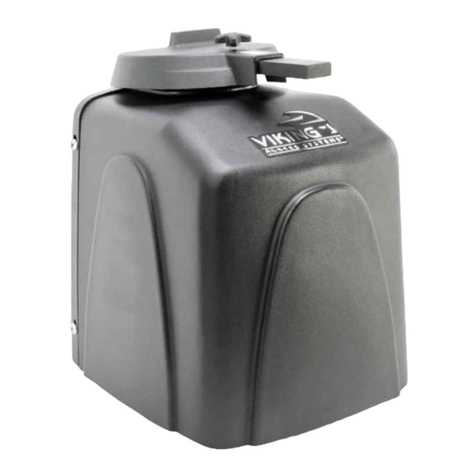
Viking
Viking R-6 Installation instructions and safety information

Tormatic
Tormatic Novotron 171 quick start guide
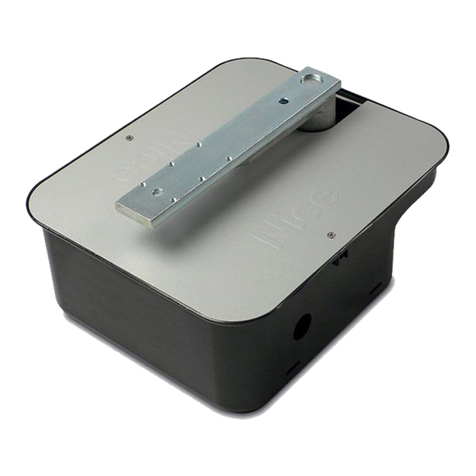
Nice
Nice MFAB3000 Instructions and warnings for installation and use
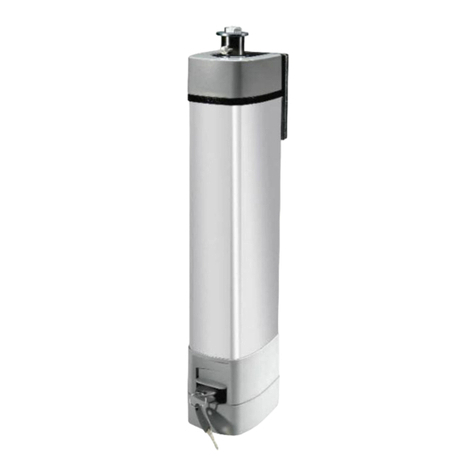
CAME
CAME STYLO Series installation manual

SOMFY
SOMFY Elixo 500 230V RTS installation manual

Merlin
Merlin Swing A 200 Quick reference guide
